| Travel Photos Home Page |
Naples, Italy 2018
|
||||
|
To return to the Paintings section of this website, please CLICK HERE
|
|||
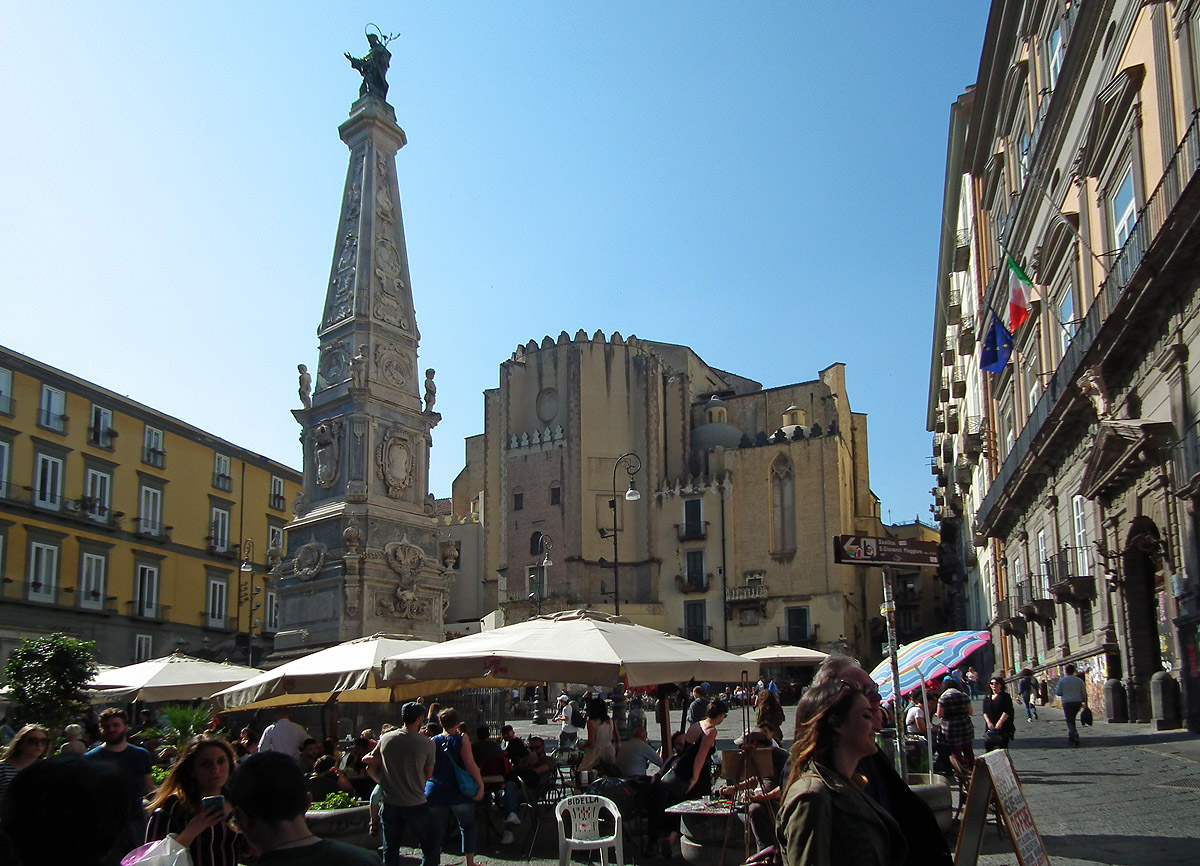 |
|||
| Naples has had a long and varied history since it was founded as an Ancient Greek colony more than two thousand years ago. It was the capital first of the Duchy of Naples (661-1139), then the Kingdom of Naples and finally the Two Sicilies before it became part of Unified Italy in 1861.
It has much to offer the tourist and is a good base for day trips to interesting places fairly close by. I will start our tour with sites in Naples itself and end with places to visit as day trips. |
|||
 |
|||
| This is the Castel dell'Ovo. It is the oldest standing fortification in Naples and it was built on the island of Megaride which was where the Ancient Greeks formed their first colony in the 6th Century BC.
Megaride is now joined to the mainland with a spit. |
|||
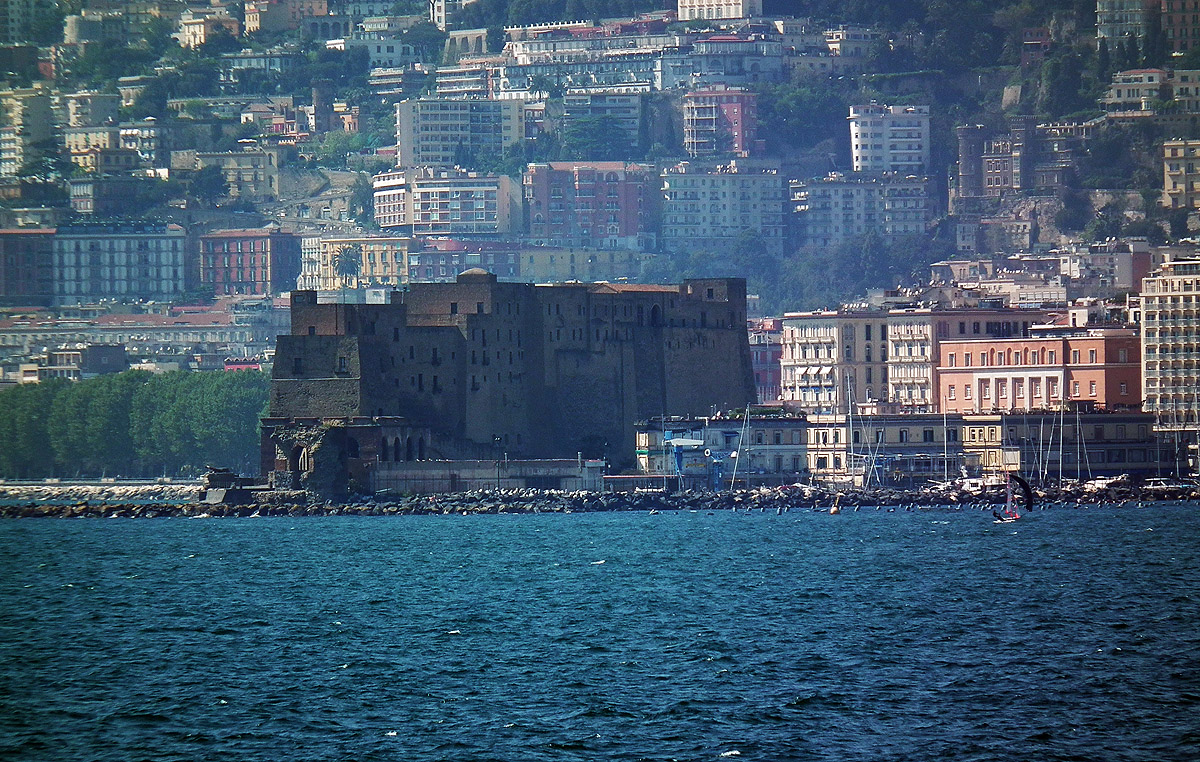 |
|||
| I took this photo of the Castel dell'Ovo from a ferry when I was on my way to the Island of Ischia, | |||
 |
|||
| Inside the Castel dell'Ovo. | |||
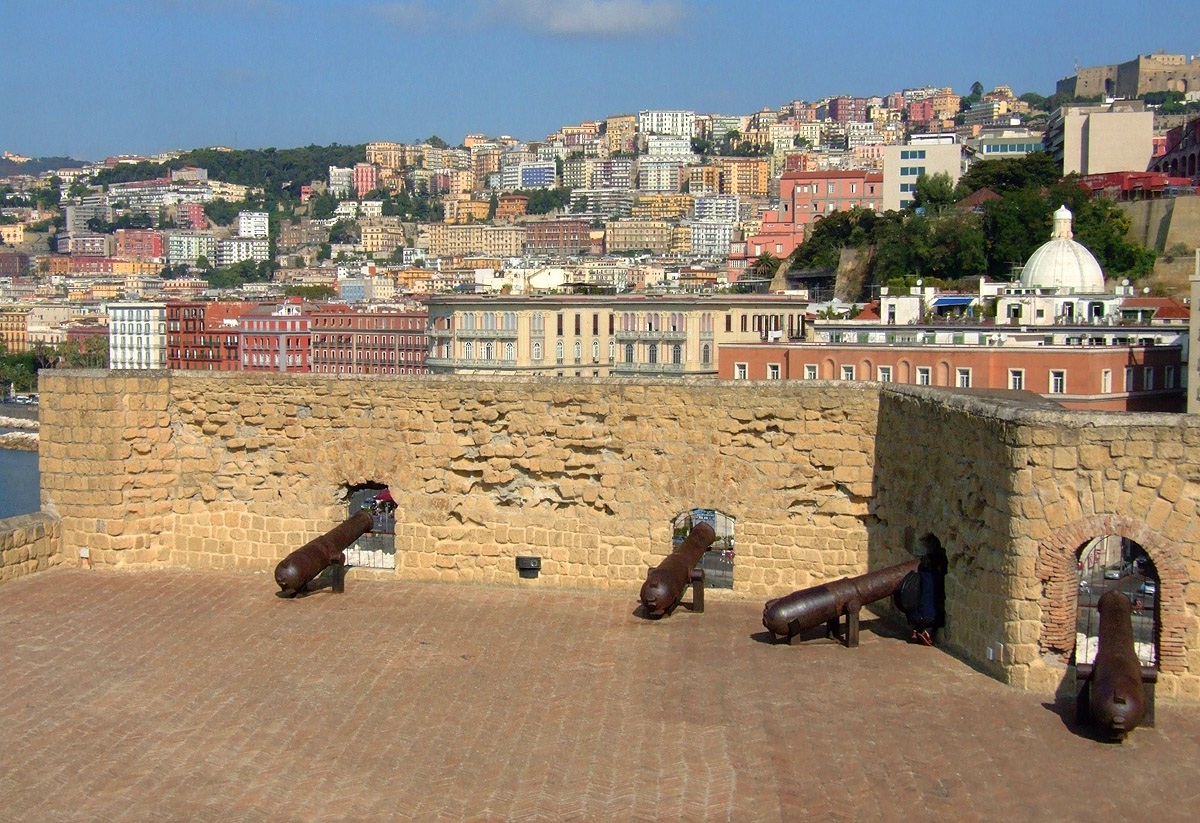 |
|||
| There are good views of Naples and its harbour from the walls of the Castel dell'Ovo. | |||
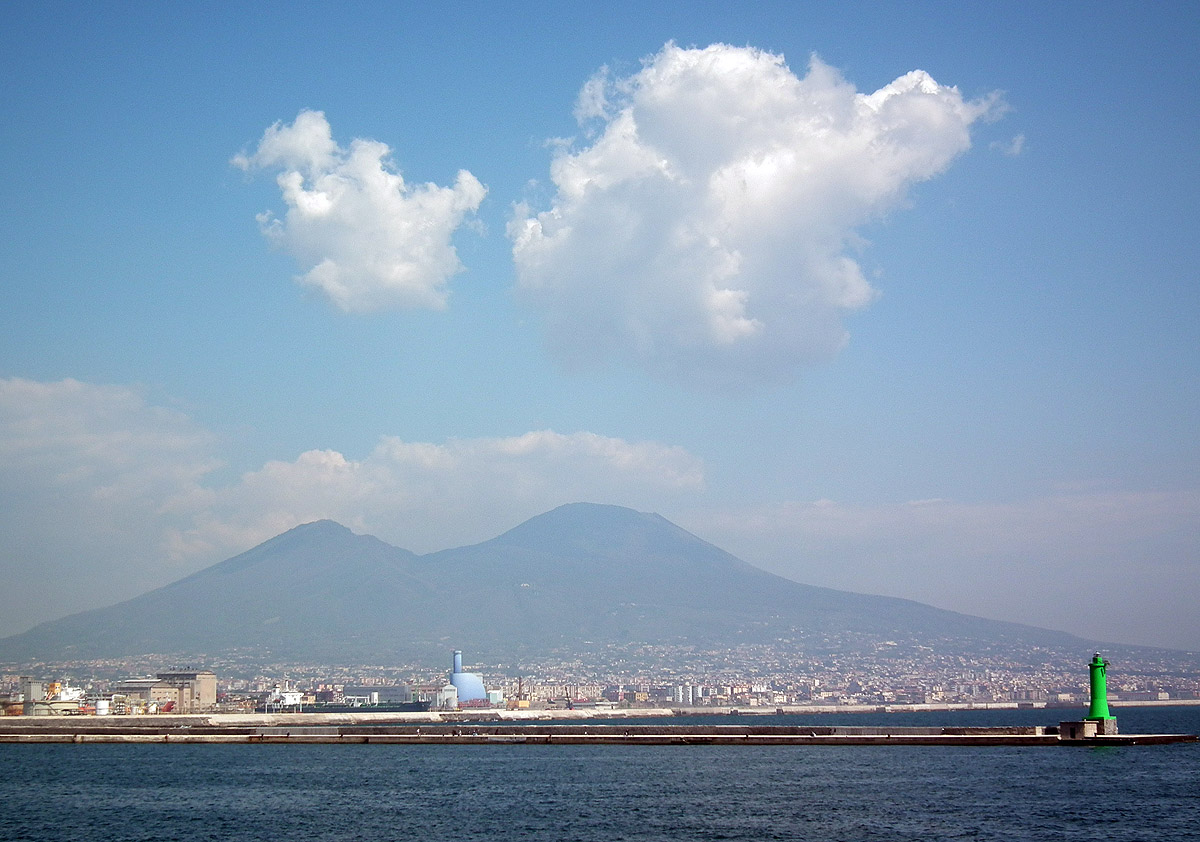 |
|||
| Vesuvius is a reminder of the volcanic past of this region called Campania. Pompeii is almost a suburb of Naples, easily reached by a local train. | |||
 |
|||
| Naples has a very large Old Town Centre, fairly close to the main railway station, Napoli Centrale.
This is the Obelisk of San Domenico in the Piazza San Domenico Maggiore, less than a kilometre West of the Station. The obelisk is topped by a statue of Saint Dominic and it was erected as a holy precaution after the plague of 1656. |
|||
 |
|||
| There are many Churches in Naples. This is the rear of San Domenico Maggiore showing the exterior walls of the Apse. | |||
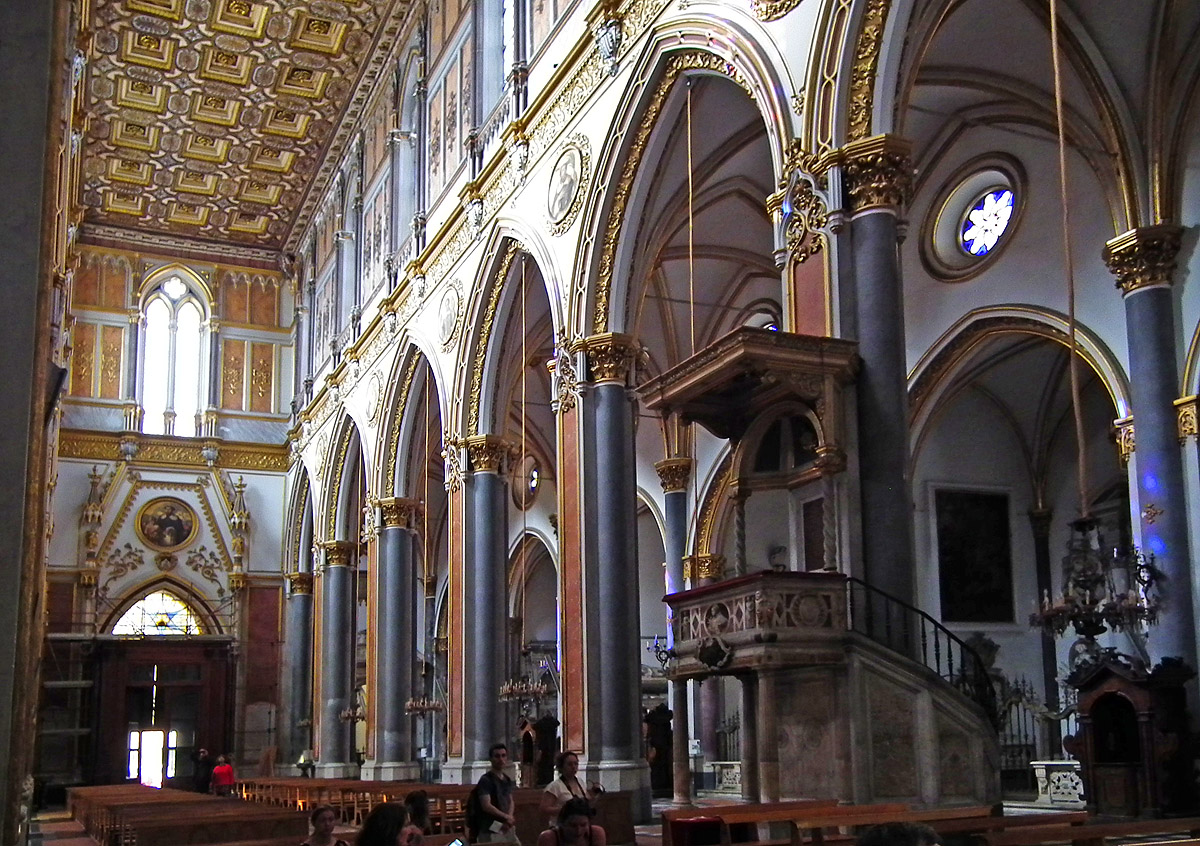 |
|||
| The Nave and Pulpit of San Domenico Maggiore facing the entrance to the church.
There was a monastery attached to this church in years past which was the original seat of the University of Naples. For a time the monastery was the home of such distinguished teachers as Thomas Aquinas and Giordano Bruno. |
|||
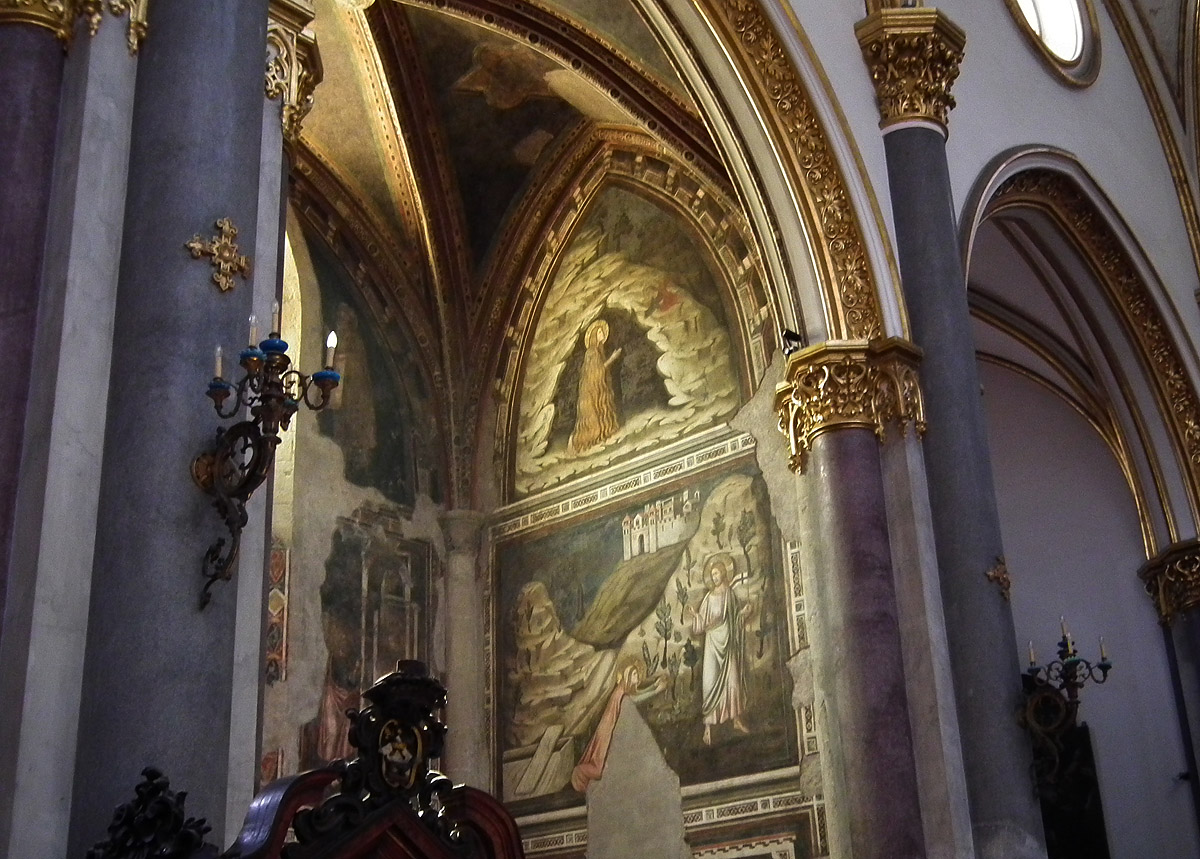 |
|||
| San Domenico is richly decorated with a number of old frescoes. | |||
 |
|||
| This is the facade of the Catheral of Naples. It is only about 200 metres North East of San Domenico Maggiore. | |||
 |
|||
| .The Nave of the Cathedral, facing the Altar | |||
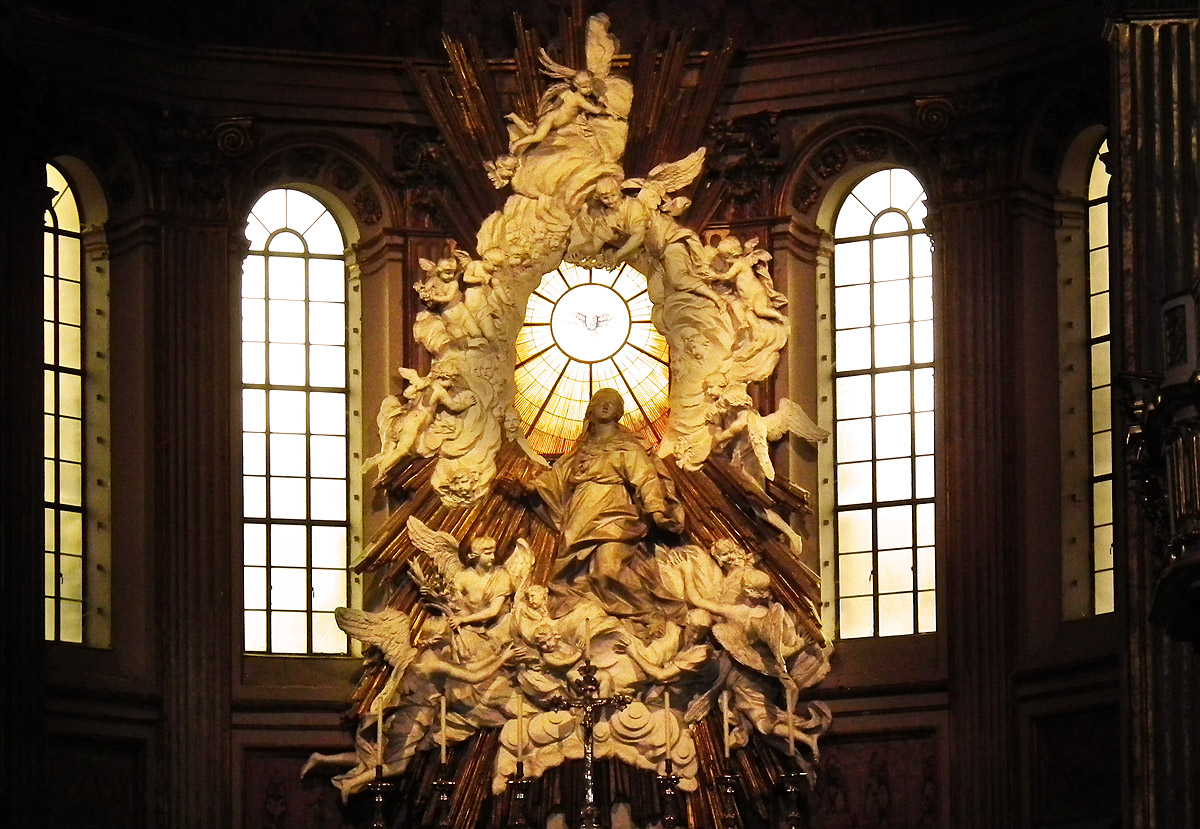 |
|||
| The Baroque "sun-burst" behind the altar. The Cathedral itself was completed in the 14th Century. | |||
 |
||||
| Frescoes in the Cathedral of Naples. | ||||
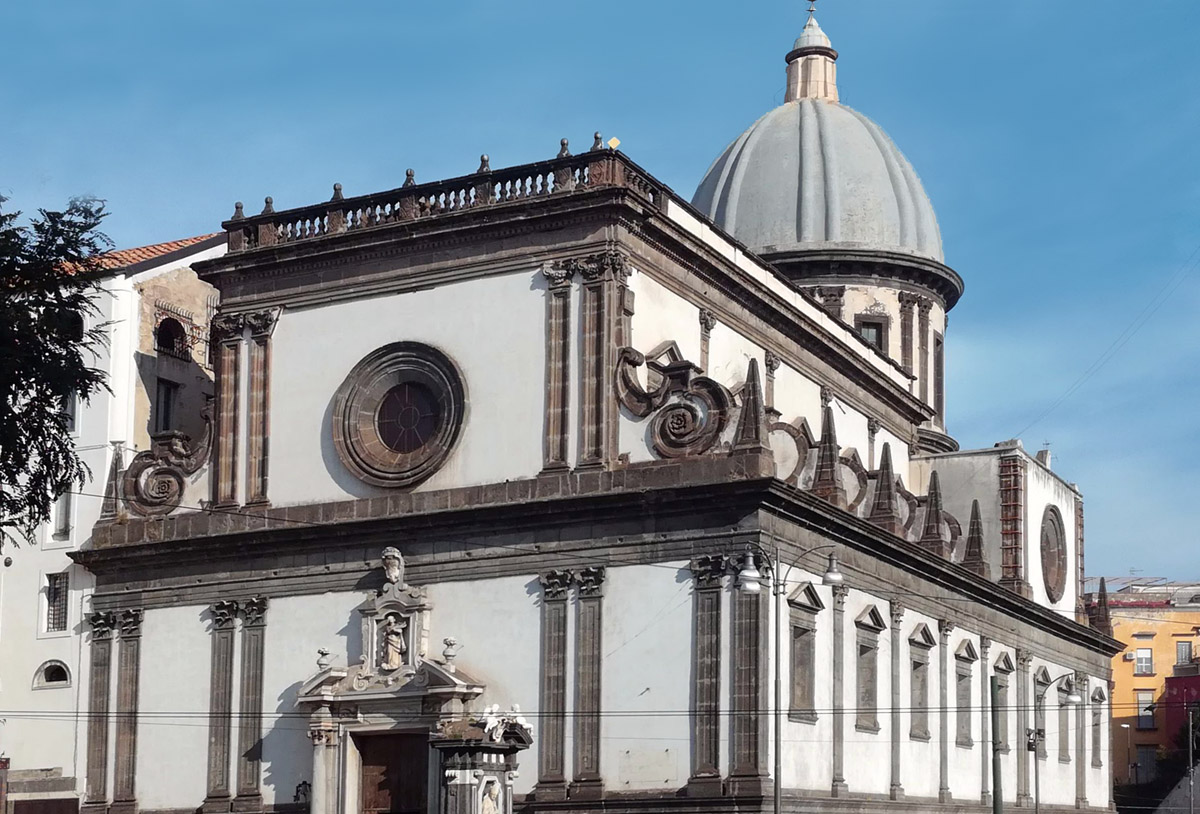 |
|||
| This is the Church of Santa Caterina a Formiello. It is on the Eastern end of the Old Town, close to the main railway station. | |||
 |
|||
| What attracted my attention in this Church were two tombs belonging to the Spinelli family of Cariati. The funereal monuments were made by two Milanese sculptors, Scilla and Giannotto. | |||
 |
||
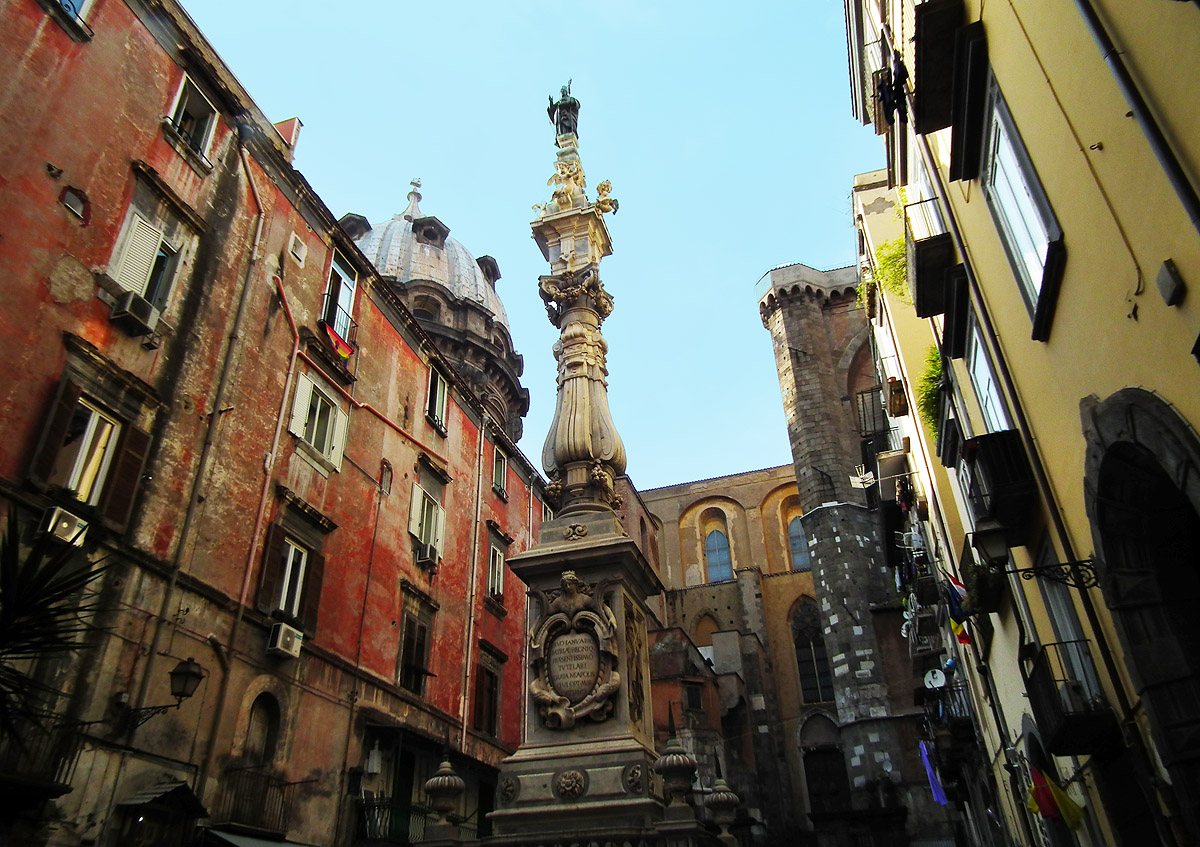 |
|||
| This is the Obelisk of Saint Gennaro (Januarius). Januarius is the patron saint of Naples.
He is a martyr and a saint of the Roman Catholic and the Eastern Orthodox Churches. He died in 305 AD during the persecution of Christians in the time of the Emperor Diocletian. |
|||
 |
|||
| Naples has a large glass roofed shopping mall like the ones in Milan and Rome. When I took this photo, it was siesta time, and all the shops were closed! | |||
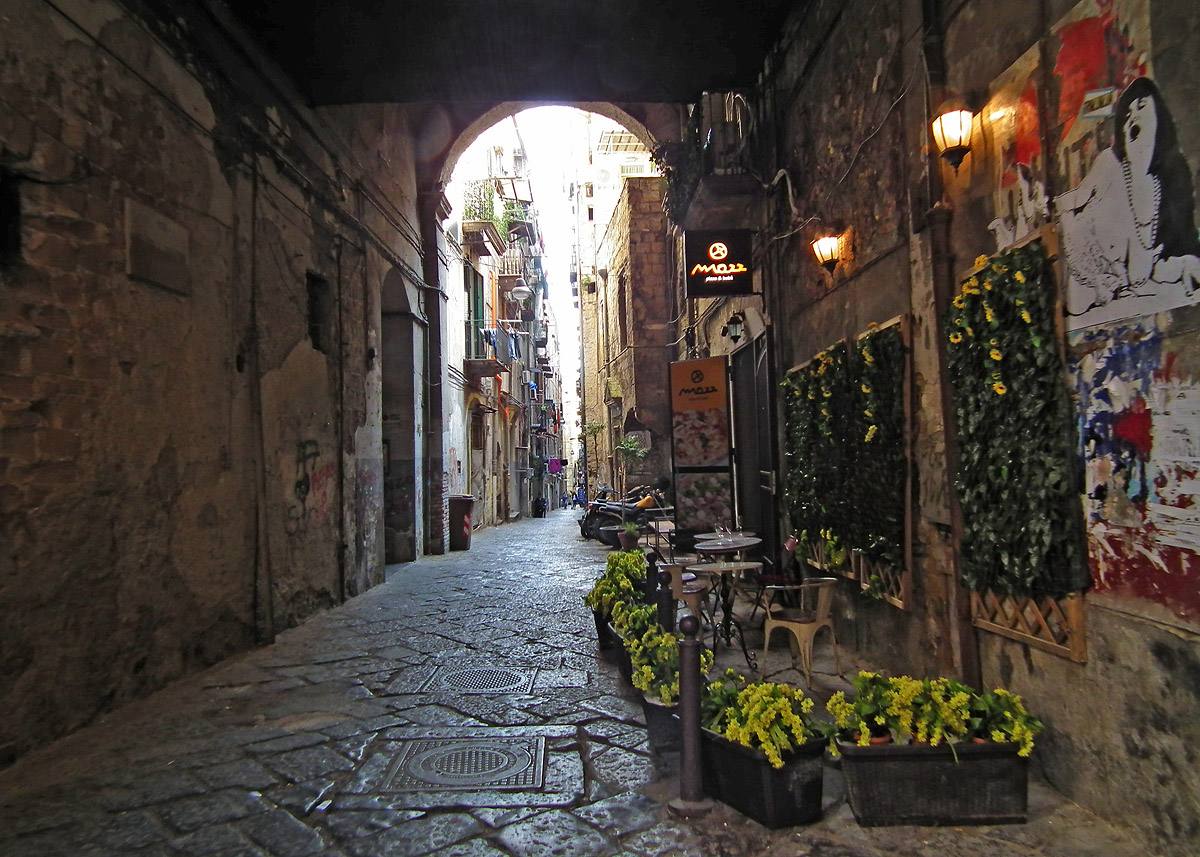 |
|||
| The Old Town of Naples is full of quaint streets and alleyways. | |||
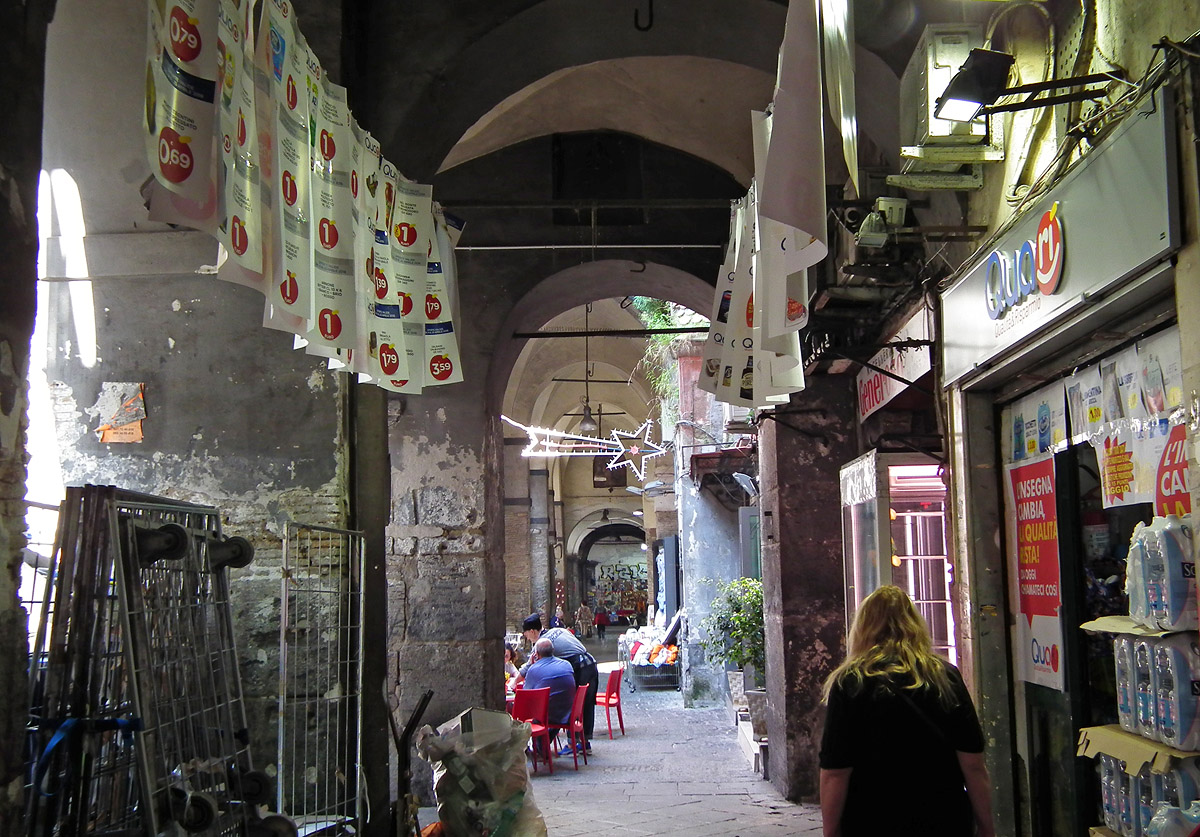 |
|||
| Many of the old streets have arcades which provide cool shade in summer for shoppers. | |||
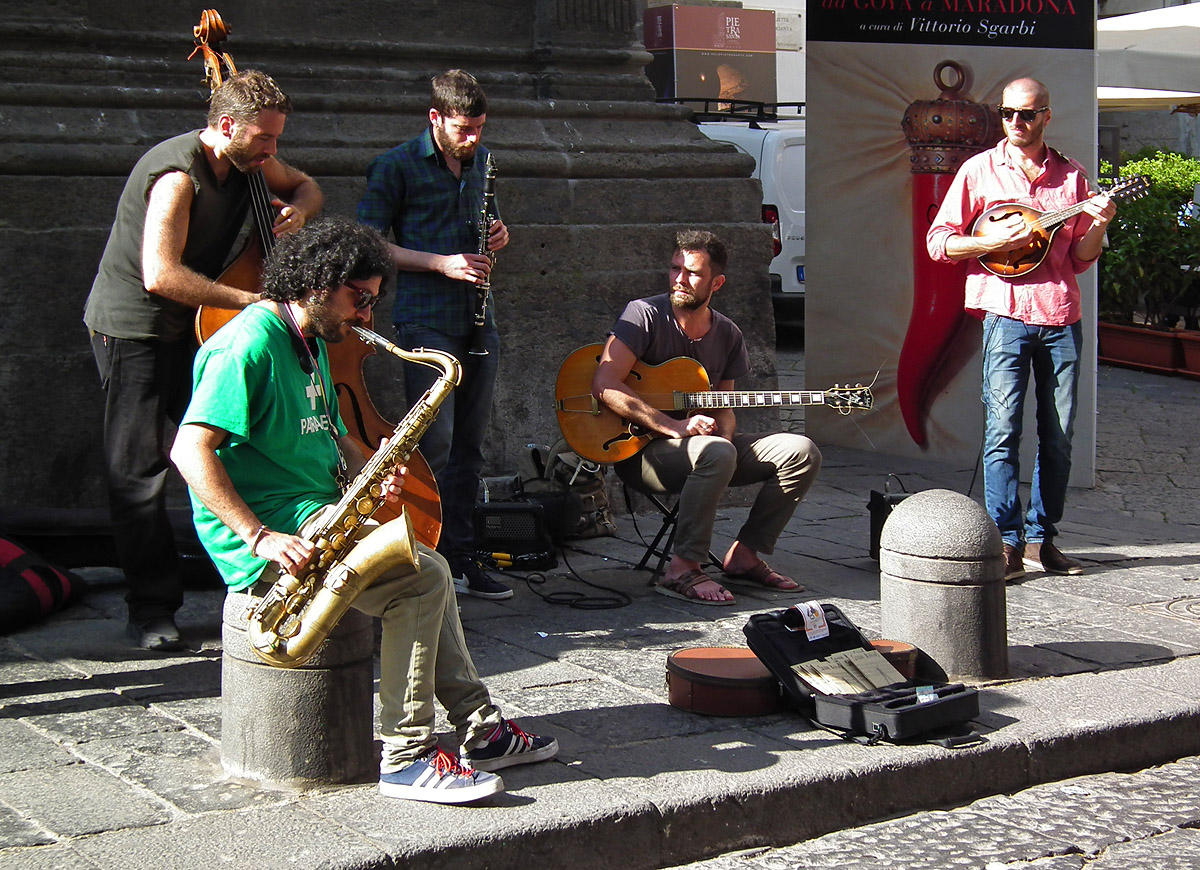 |
|||
| Buskers in the Old Town. | |||
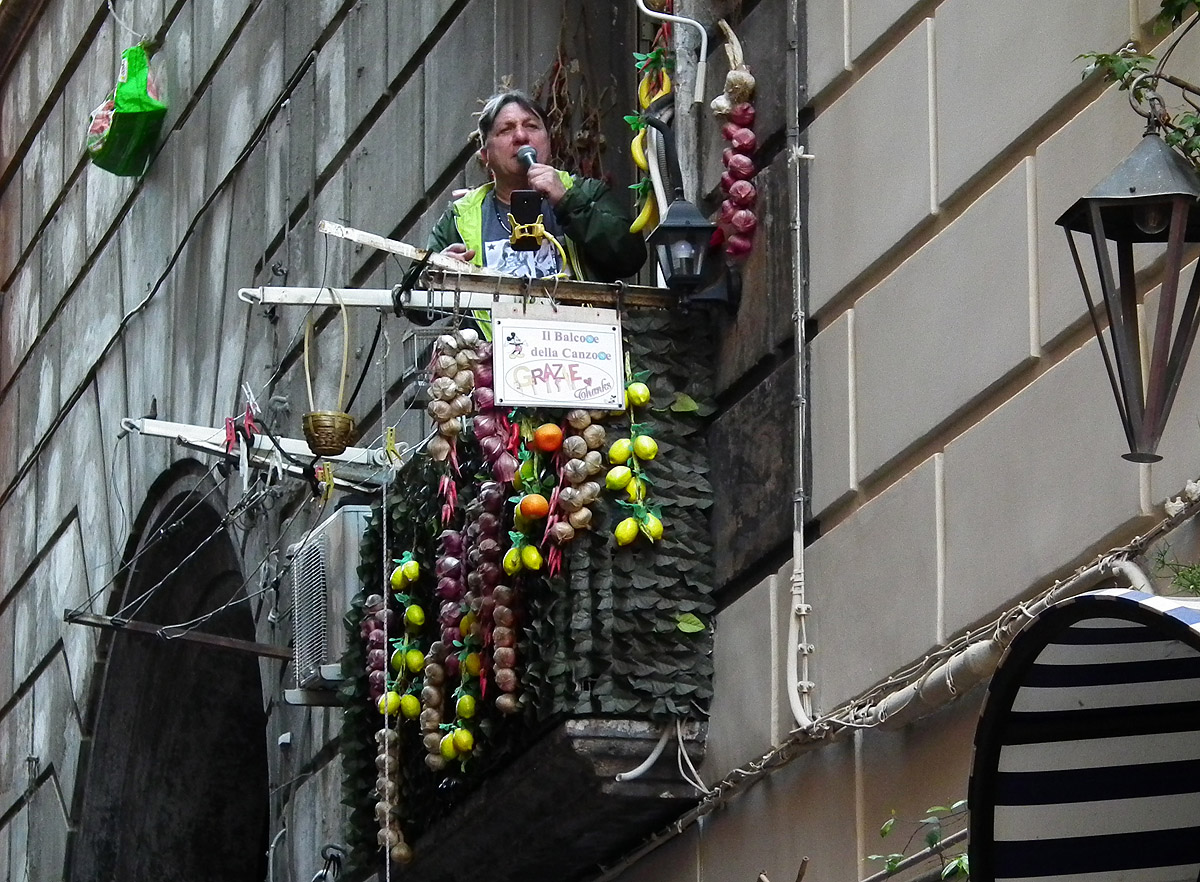 |
|||
| The sign says "Il Balcone della Canzone". This balconic singer drew great applause from the people on the street below for his rendition of traditional Neapolitan songs. There was a basket hanging from the balcony to gather the tribute money. | |||
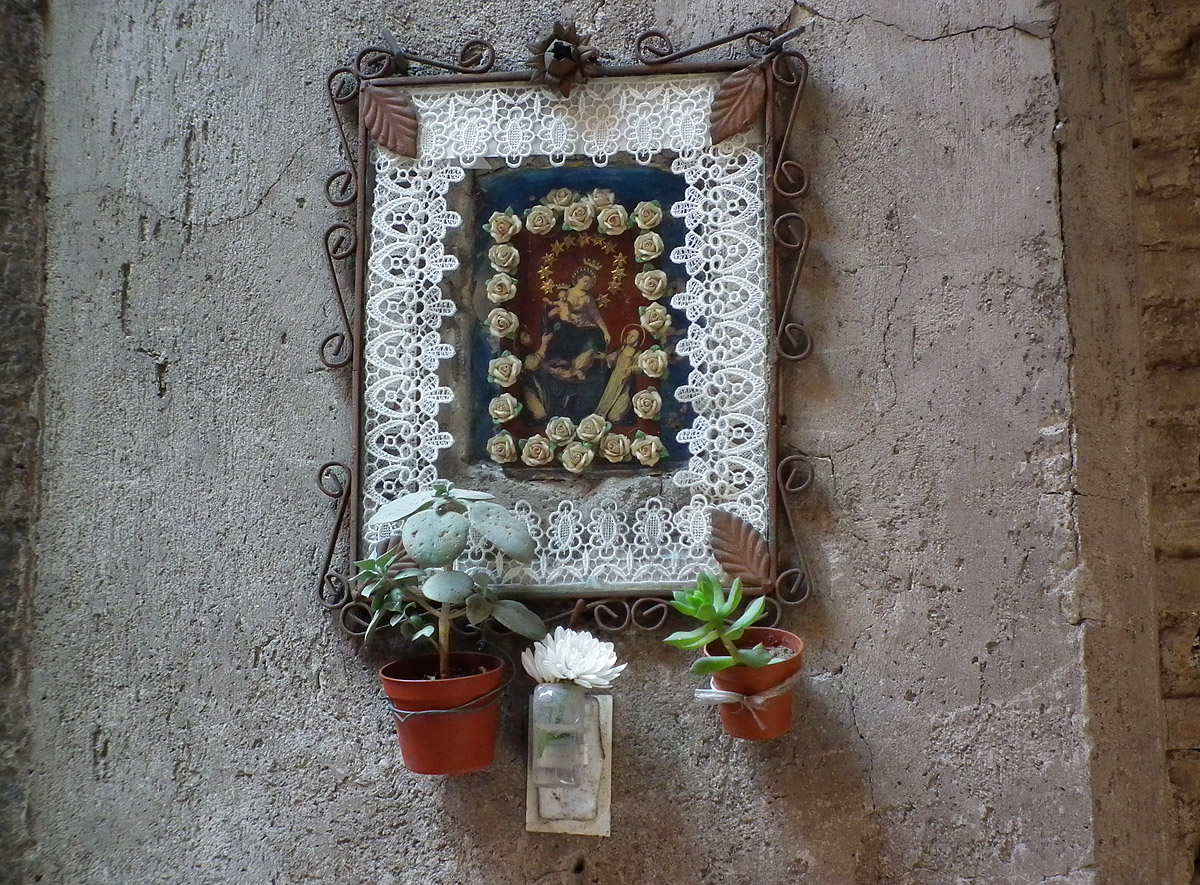 |
|||
| A home-made altar hanging on a wall in the Old Town. | |||
 |
|||
| This is the modern section of the Piazza Garibaldi. The rest of that Piazza is on the higher level above this shopping passageway. It connects the Central Station of Naples with the Circumvesuviana which is the railway station for places like Pompeii and Sorrento. | |||
 |
|||
| This equestrian statue of the Italian General Armando Diaz is in the fashionable district of Chiaia, which is to the West of the Castel dell'Ovo. The fort at the top of the hill is the Castel Sant'Elmo. | |||
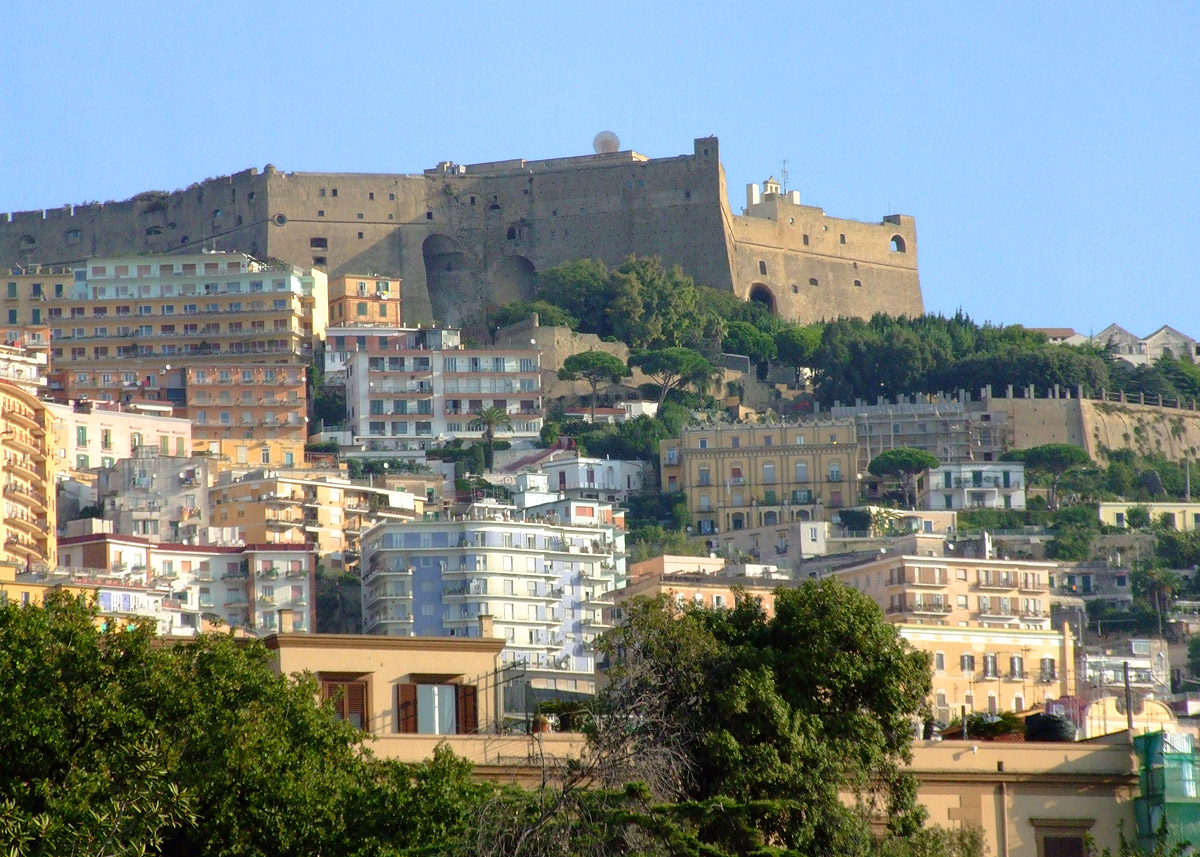 |
|||
| Castel Sant'Elmo. | |||
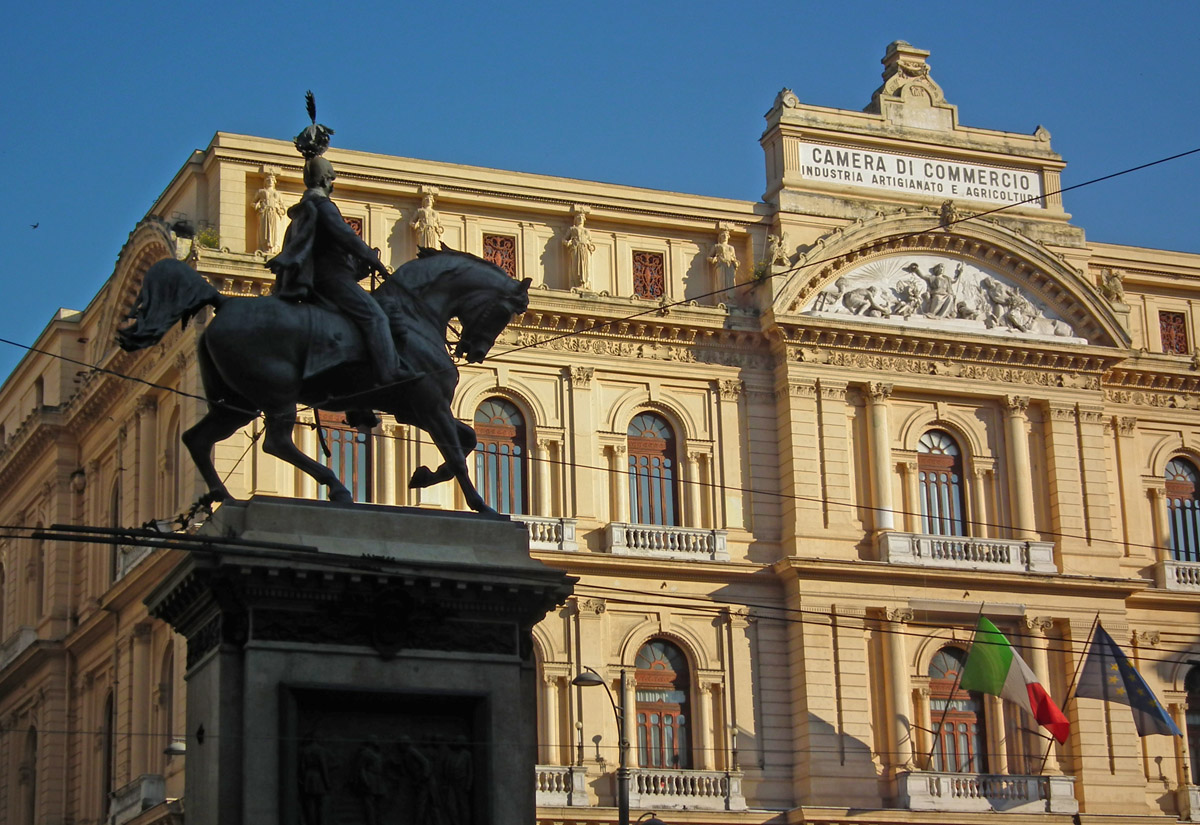 |
|||
| This building and statue are on the Corso Umberto I. The rider on the horse is Umberto I. | |||
 |
|||
| The Castel Nuovo was built in the 13th Century and was the royal residence of Charles I of Naples (Charles of Anjou). It is close to the Port of Naples. | |||
 |
|||
| There are two major institutions in Naples which make a visit to this city worthwhile just on their own. They are the National Archaeological Museum of Naples and the Museo di Capodimonte.
We start with the Archaeological Museum which houses a brilliant collection of artifacts of the Greek and Roman eras, from Pompeii, Stabiae and Herculaneum. |
|||
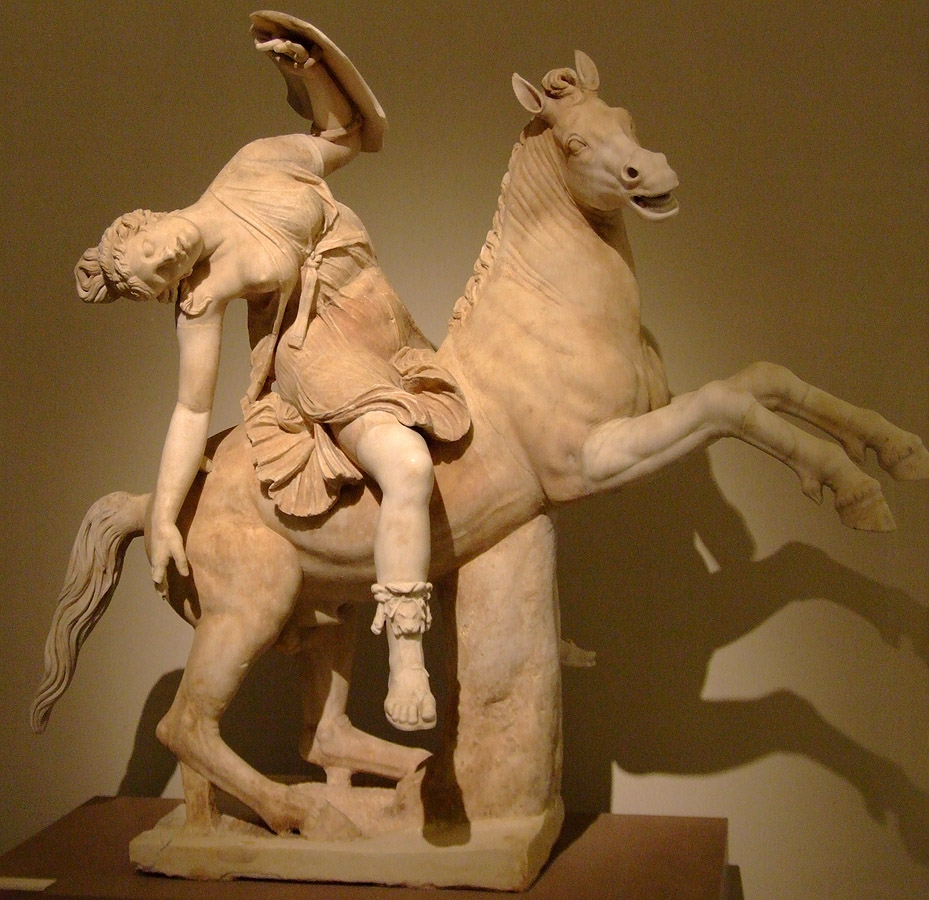 |
||||
| Amazon on Horseback, in the Archaeological Museum of Naples. | ||||
 |
|||
| This was titled "Pan and Daphne".
I always thought that Daphne was a maiden... a nymph... who was chased by the God Apollo. She escaped his clutches by being transformed into a laurel tree. This statue of Pan and "Daphne" shows the nude "Daphne" with male appendages! |
|||
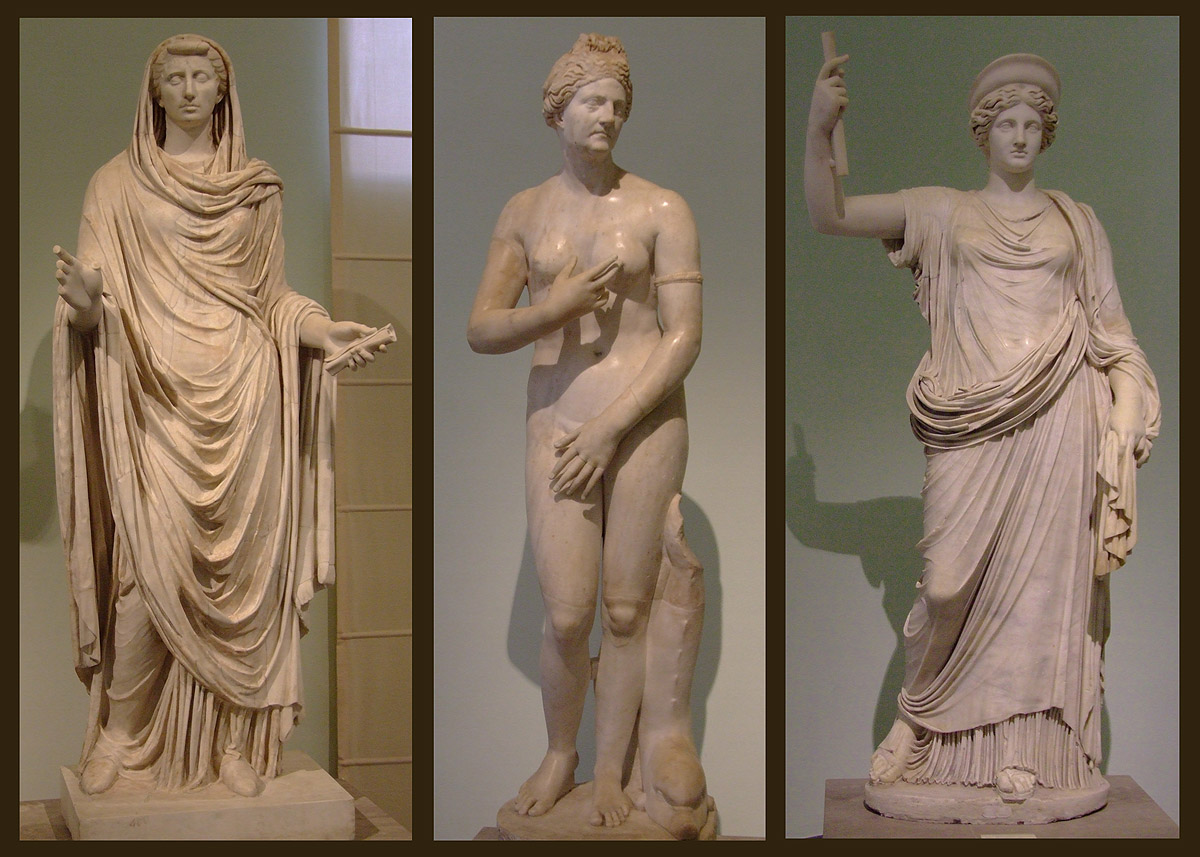 |
||
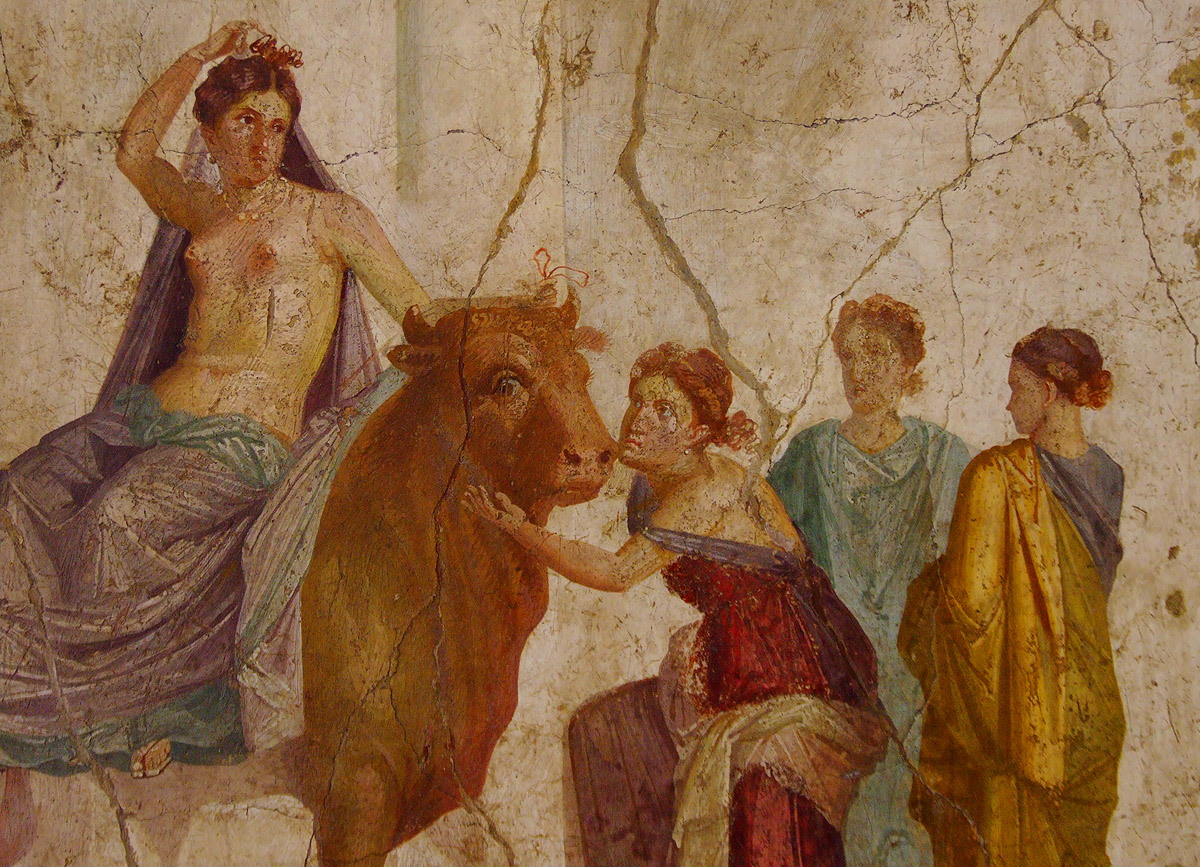 |
|||
| The following five frescoes were carefully brought here from Pompeii and Herculaneum. | |||
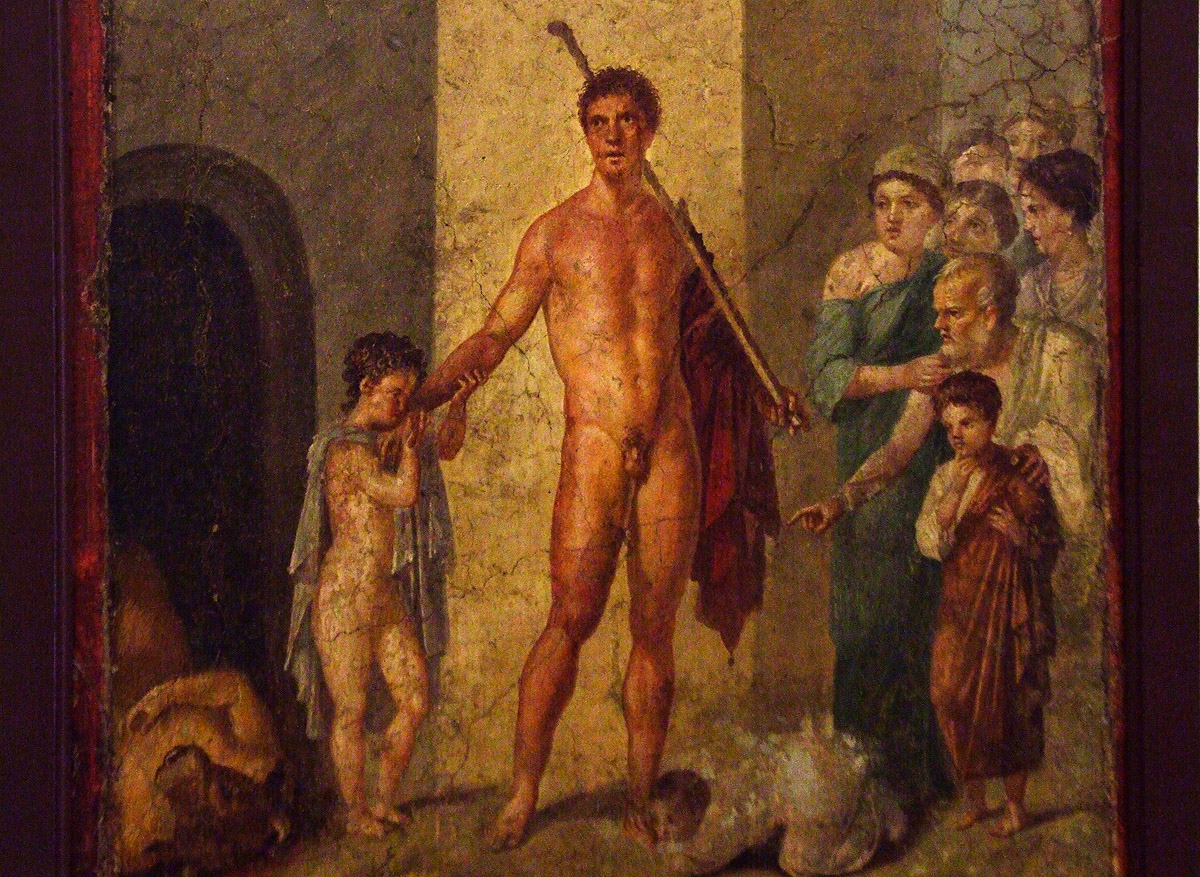 |
||
 |
|||
| Venus, Mars and Cupid? | |||
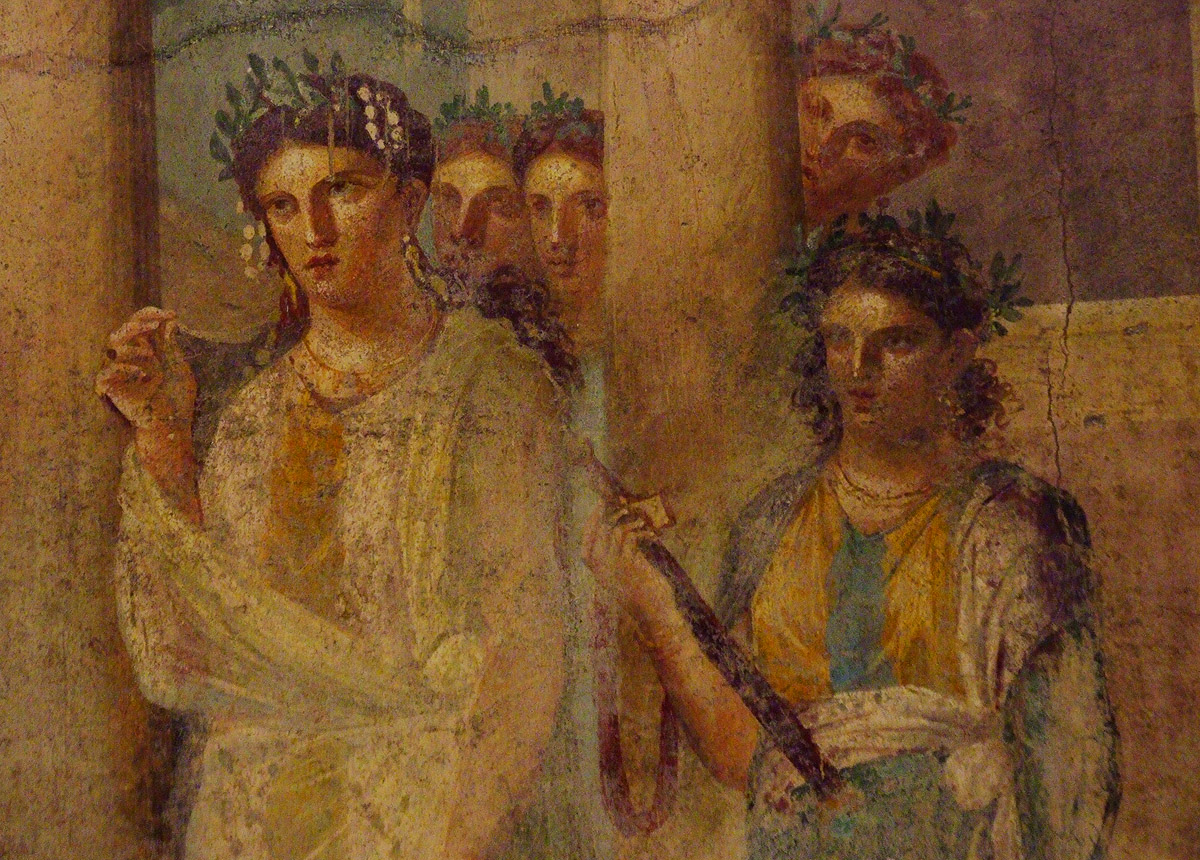 |
||
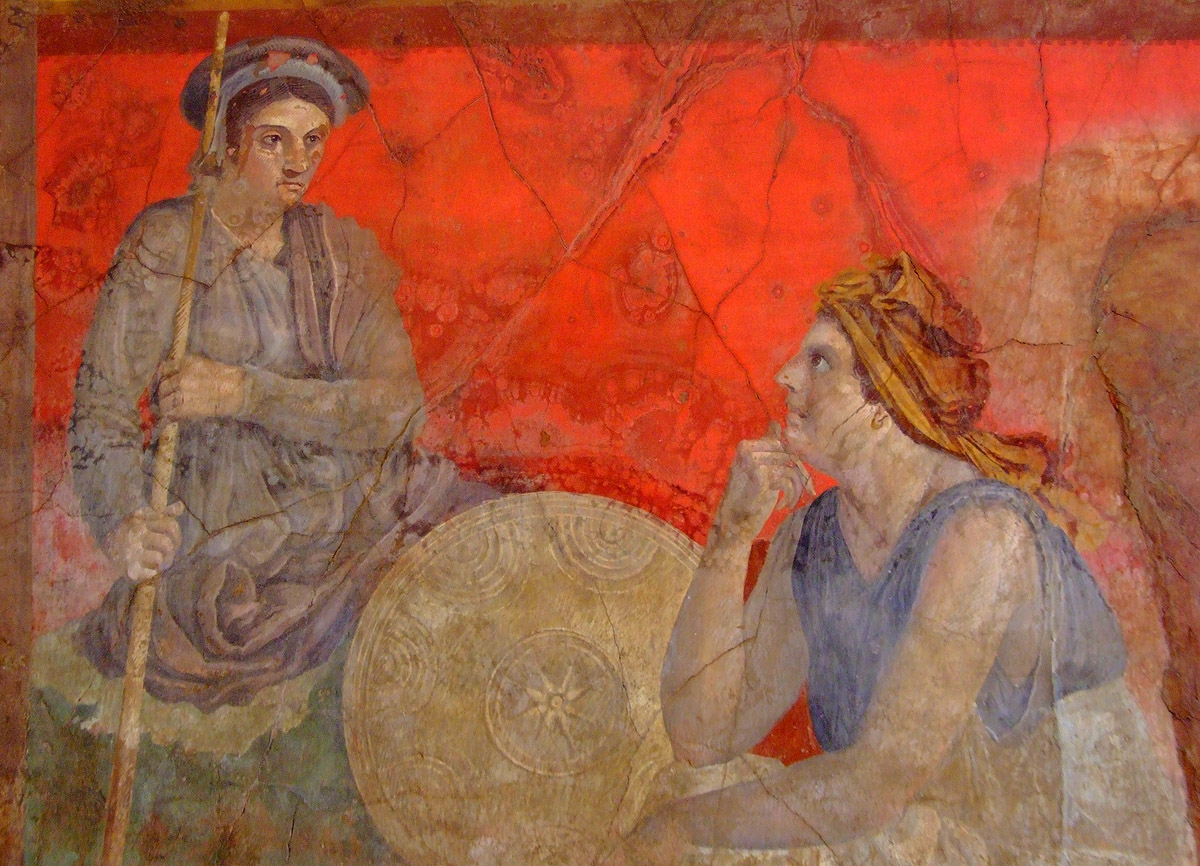 |
||
 |
|||
| The Museo di Capodimonte is a fabulous art museum housed in the Bourbon Palace of that name. It is situated high up in the hill behind Naples, and is surrounded by trees in its own extensive grounds. | |||
 |
|||
| This is "The Trnsfiguration" by Giovanni Bellini. | |||
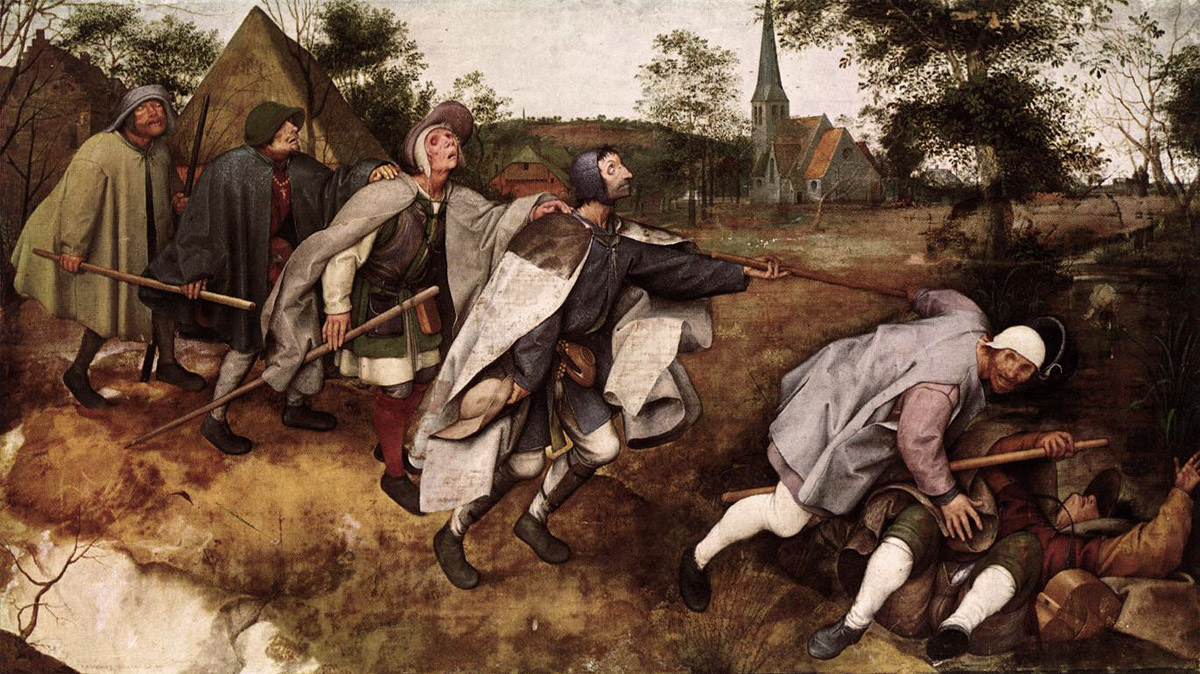 |
|||
| "The Parable of the Blind leading the Blind", by Pieter Brueghel the Elder.
If I am not mistaken, I think I once saw a copy of this painting by his son in the Louvre in Paris. |
|||
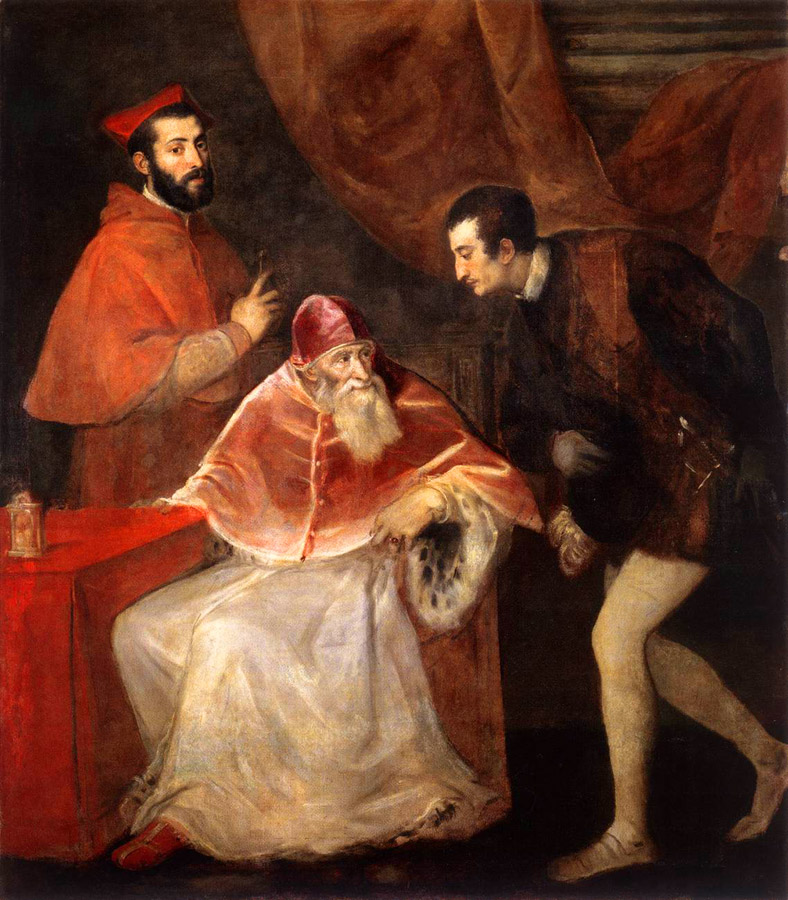 |
||||
| Titian's painting of Pope Paul III with his two grandsons. I must say that they do look suspiciously conspiratorial! | ||||
 |
||||
| "The Flagellation" by Caravaggio. | ||||
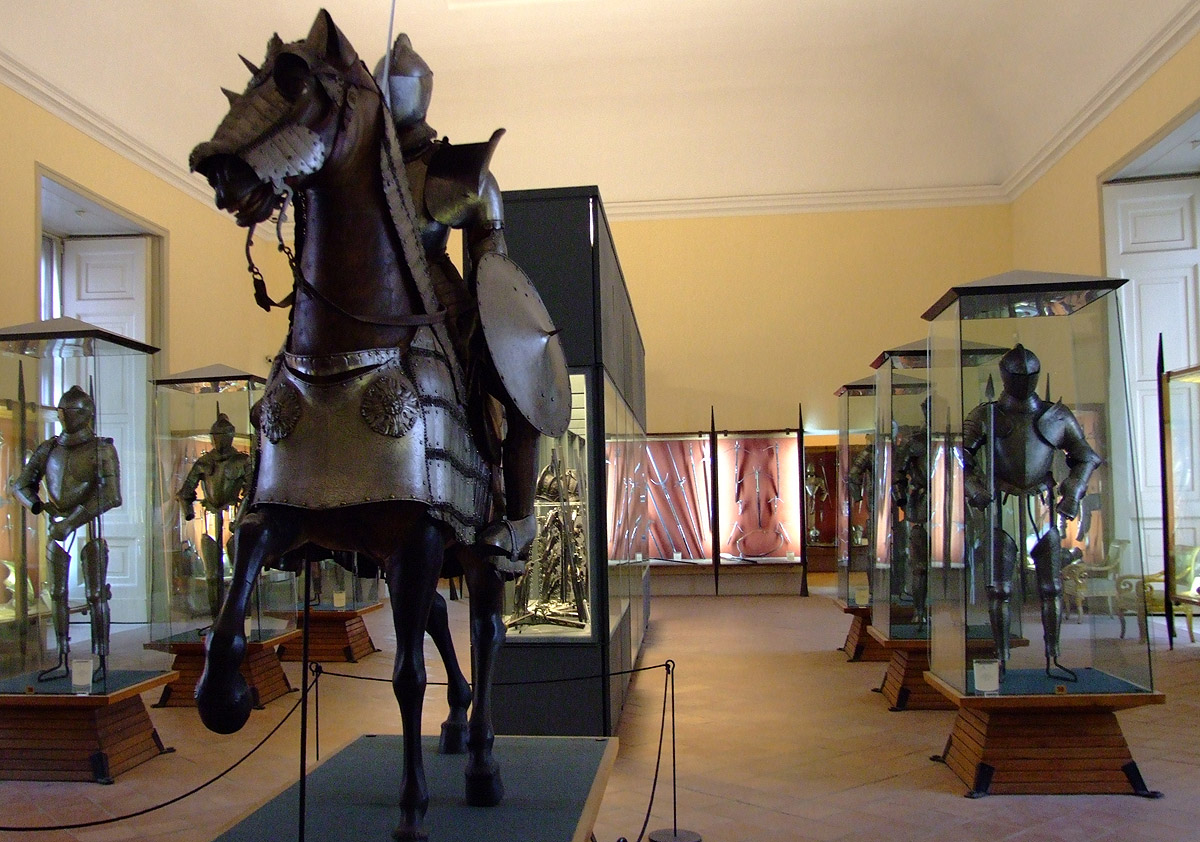 |
|||
| As a picture painter by trade, I naturally concentrated on the fabulous collection of paintings in the Capodimonte, but I am duty bound to inform the visitor that this museum has a huge and varied collection of other artifacts.
The photo above shows the Armoury Room. |
|||
 |
|||
| Back to paintings! This is the "Pieta" by Hugo van der Goes. | |||
 |
||||
| Saint Anne with Saints Peter and Paul in the Museo di Capodimonte. | ||||
| The second half of this page is devoted to various places one can easily visit as day trips from Naples. | ||||
 |
|||
| A short train ride from Naples on the Circumvesuviana railway will take us to Pompeii. We pass Herculaneum on the way here.
In the background of this photo is Mount Vesuvius, which erupted in 79 AD with devastating effect. |
|||
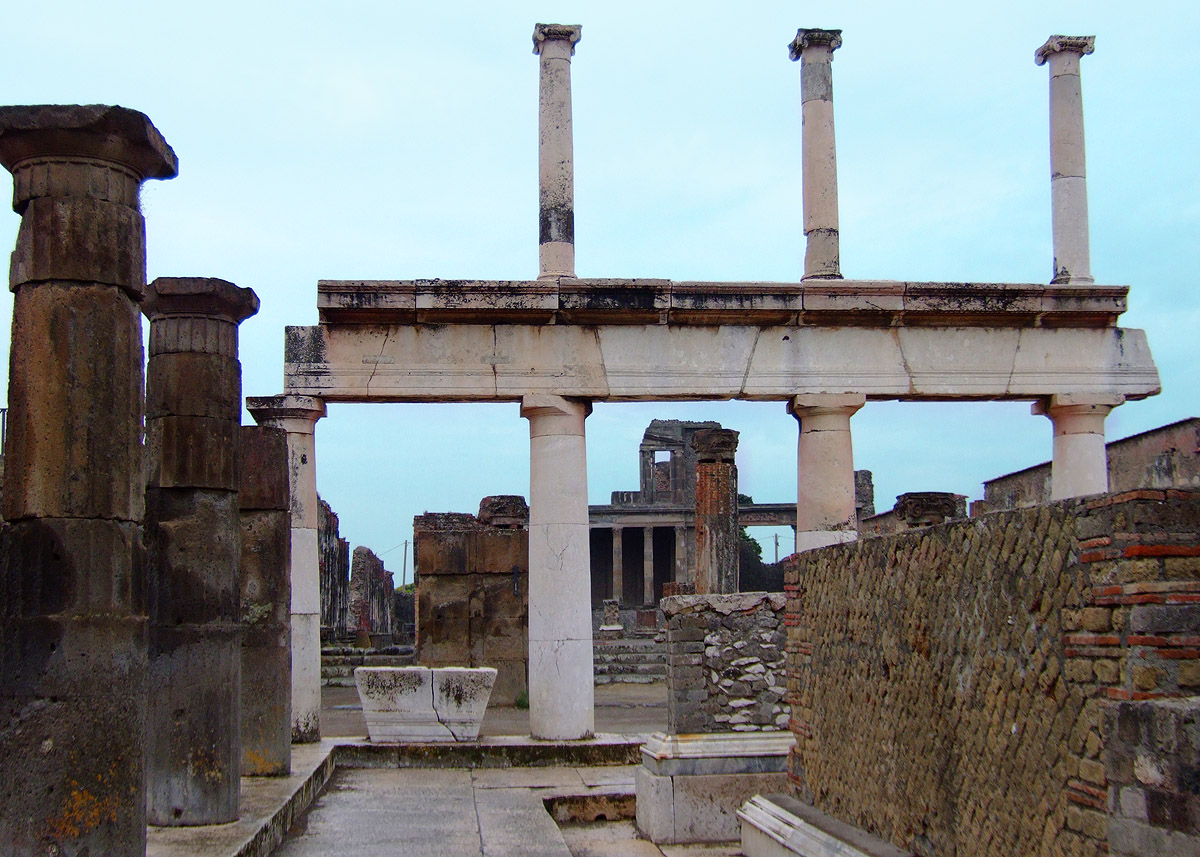 |
|||
| Ruins of a Temple in Pompeii. | |||
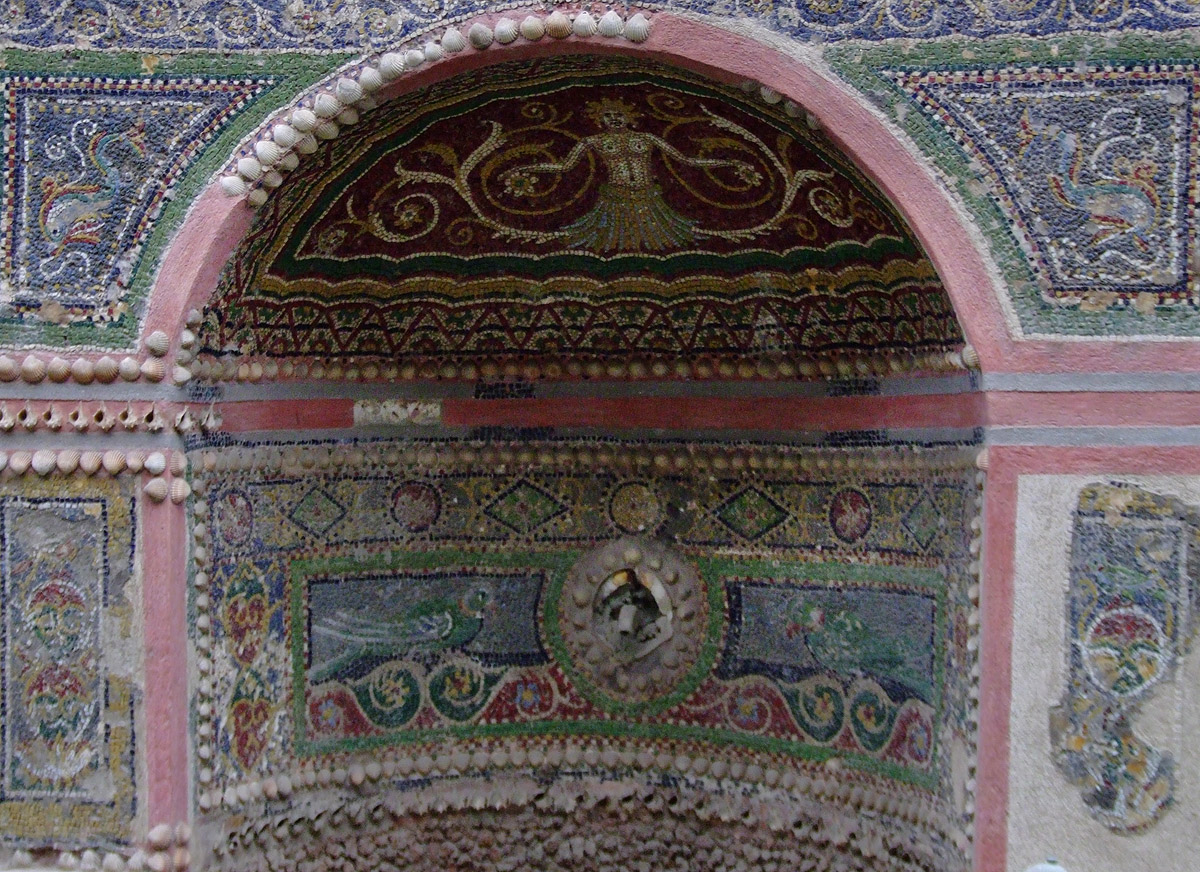 |
|||
| This is in the House of the Small Fountain in Pompeii. | |||
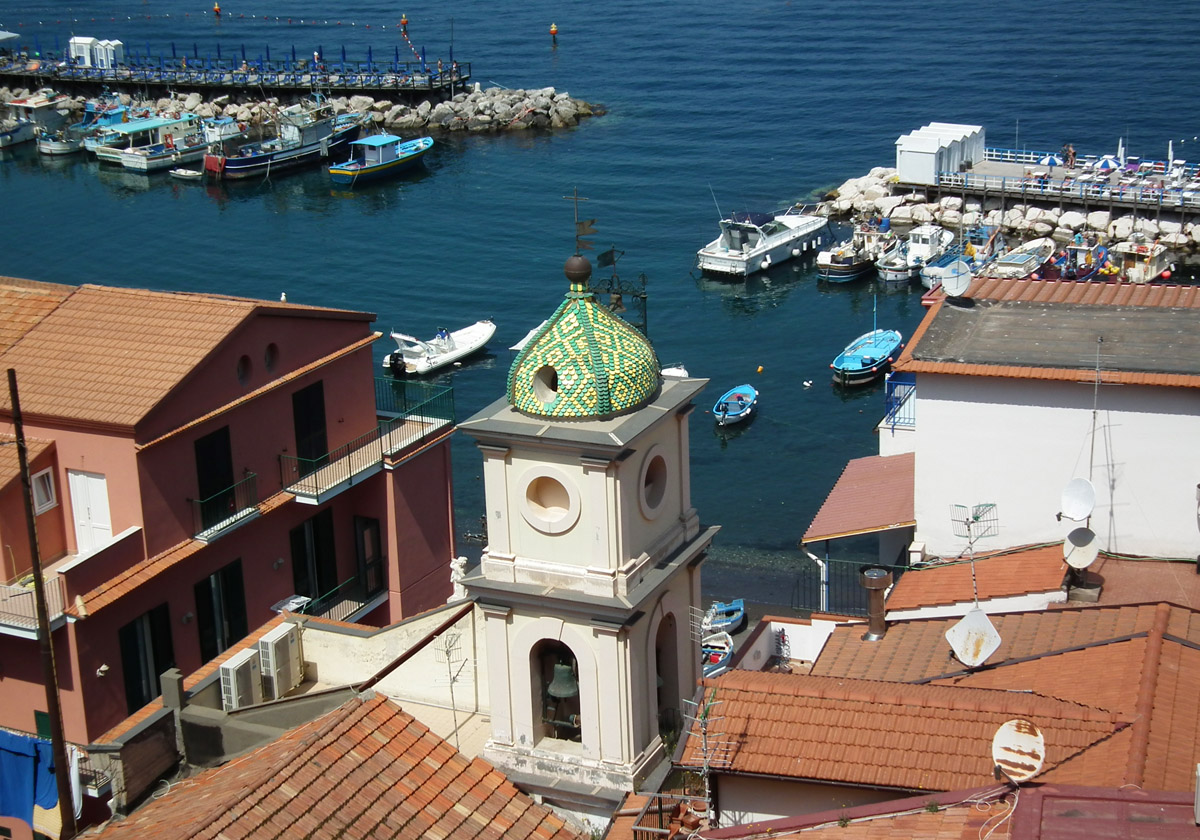 |
|||
| Further East of Pompeii on the Circumvesuviana we arrive in Sorrento.
In 2009, I stayed in Sorrento for 11 nights which gave me plenty of time to explore the Amalfitana (the Amalfi Coast), as well as Capri. |
|||
 |
|||
| Most of Sorrento is built above these cliffs. In years past, the cliffs were heavily fortified to keep the citizens of Sorrento safe from pirates and other pests. | |||
 |
|||
| Sorrento is a great place to stroll around and there are plenty of cafes and restaurants to cater for all the visitors who flock here. | |||
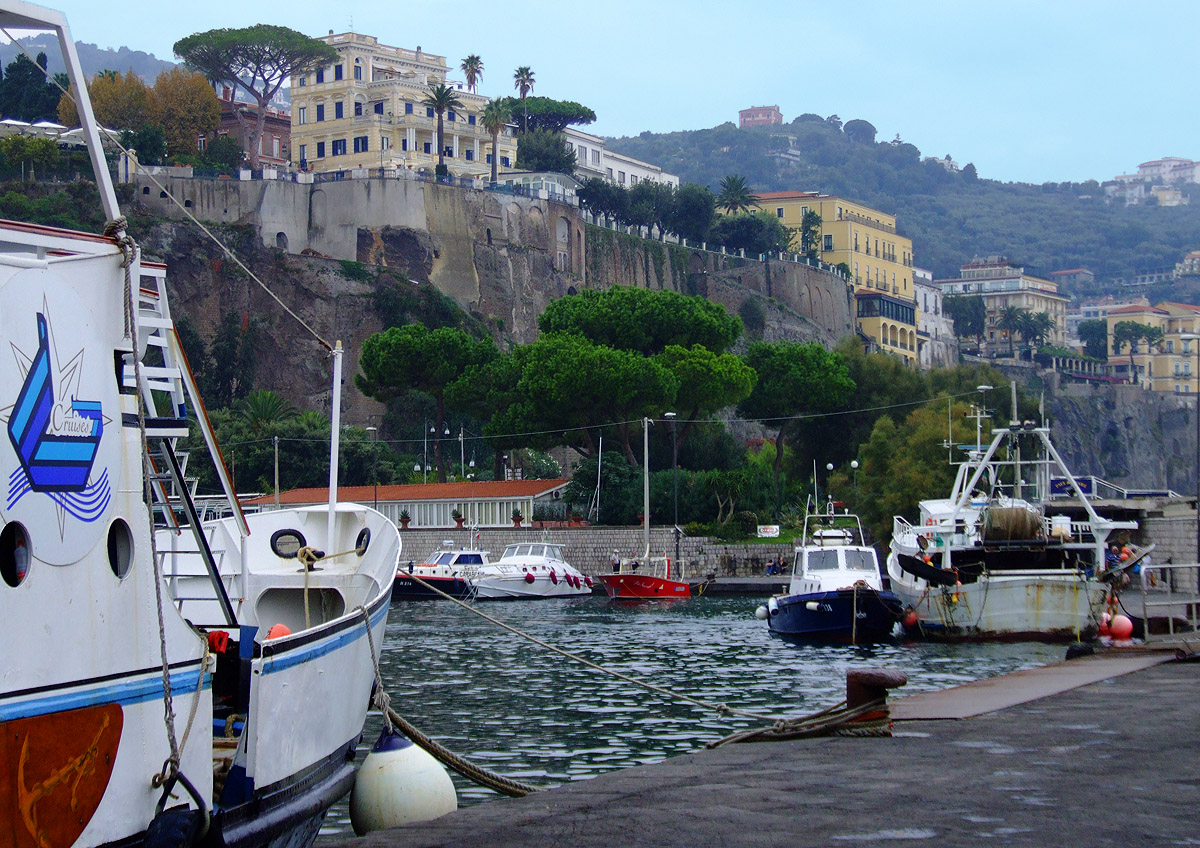 |
|||
| This is the sheltered harbour in Sorrento where we can catch ferries to Capri, Amalfi and Naples. | |||
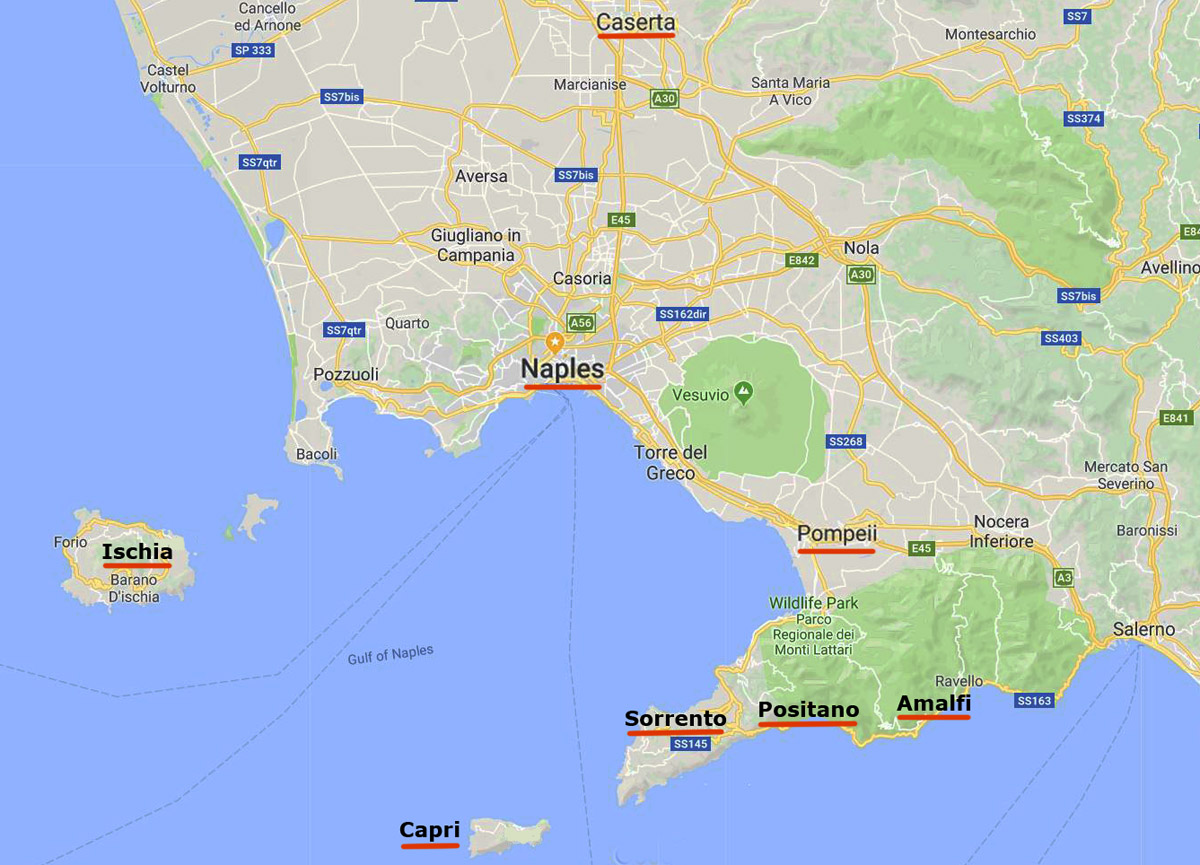 |
|||
| This map shows possible day trips from Naples. The destinations we visit on this page are underlined in red. | |||
 |
|||
| Amalfi, looking towards the West and to the famous coast of the Amalfitana. | |||
 |
|||||
| Saint Andrew's Cathedral of Amalfi dates back to the 11th Century.
Amalfi may now be viewed as a beautiful but tiny township on the Gulf of Salerno, but it has had an illustrious history which deserves to be understood. Let Wikipedia tell its story: "First mentioned in the 6th century, Amalfi soon afterwards acquired importance as a maritime power, trading grain from its neighbours, salt from Sardinia and slaves from the interior, and even timber, in exchange for the gold dinars minted in Egypt and Syria, in order to buy the Byzantine silks that it resold in the West. Grain-bearing Amalfi traders enjoyed privileged positions in the Islamic ports, Fernand Braudel notes. The Amalfi tables (Tavole amalfitane (it)) provided a maritime code that was widely used by the Christian port cities. Merchants of Amalfi were using gold coins to purchase land in the 9th century, while most of Italy worked in a barter economy. In the 8th and 9th century, when Mediterranean trade revived it shared with Gaeta the Italian trade with the East, while Venice was in its infancy, and in 848 its fleet went to the assistance of Pope Leo IV against the Saracens. |
In 1073 the republic fell to the Norman countship of Apulia, but was granted many rights. A prey to the Normans who encamped in the south of Italy, it became one of their principal posts. However, in 1131, it was reduced by King Roger II of Sicily, who had been refused the keys to its citadel. The Holy Roman Emperor Lothair, fighting in favour of Pope Innocent II against Roger, who sided with the Antipope Anacletus, took him prisoner in 1133, assisted by forty-six Pisan ships. The Pisans, commercial rivals of the Amalfitani, sacked the city; Lothair claimed as part of the booty a copy of the Pandects of Justinian which was found there. In 1135 and 1137, it was taken by the Pisans and rapidly declined in importance, though its maritime code, known as the Tavole amalfitane (it), was recognized in the Mediterranean until 1570. A tsunami in 1343 destroyed the port and lower town, and Amalfi never recovered to anything more than local importance. In medieval culture Amalfi was famous for its flourishing schools of law and mathematics. Flavio Gioia, traditionally considered the first to introduce the mariner's compass to Europe, is said to have been a native of Amalfi. Amalfi has a long history of catering for visitors, with two former monasteries being converted to hotels at a relatively early date, the Luna Convento in the second decade of the 19th century and the Cappuccini Convento in the 1880s. Celebrated visitors to Amalfi included the composer Richard Wagner and the playwright Henrik Ibsen, both of whom completed works whilst staying in Amalfi. Author Gore Vidal was a long time resident." |
||||
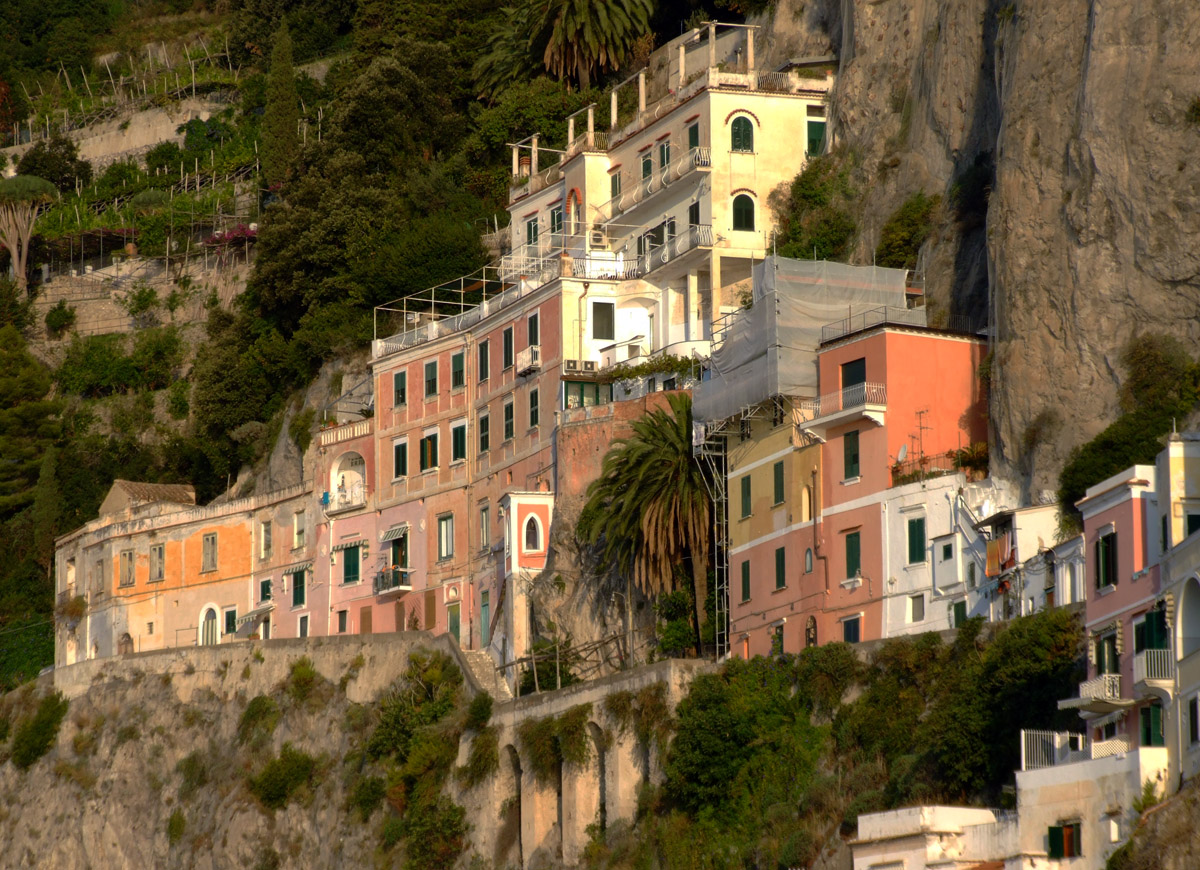 |
|||
| Buildings in Amalfi, perched up against the steep cliffs. | |||
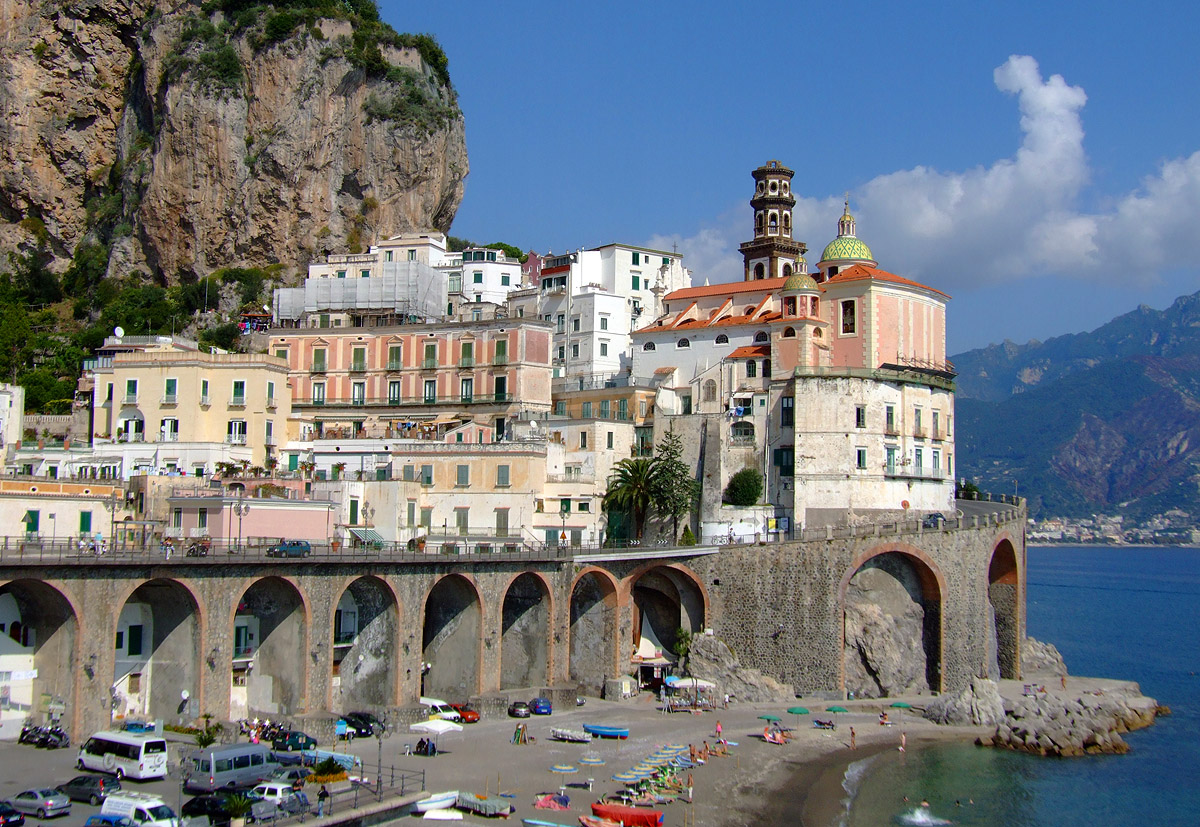 |
|||
| This is Atrani, which is half a kilometre East of Amalfi, heading in the direction of Salerno. | |||
 |
|||
| This photo was taken in 2009 when I walked from Ravello down steep mountain paths to Atrani on the coast. | |||
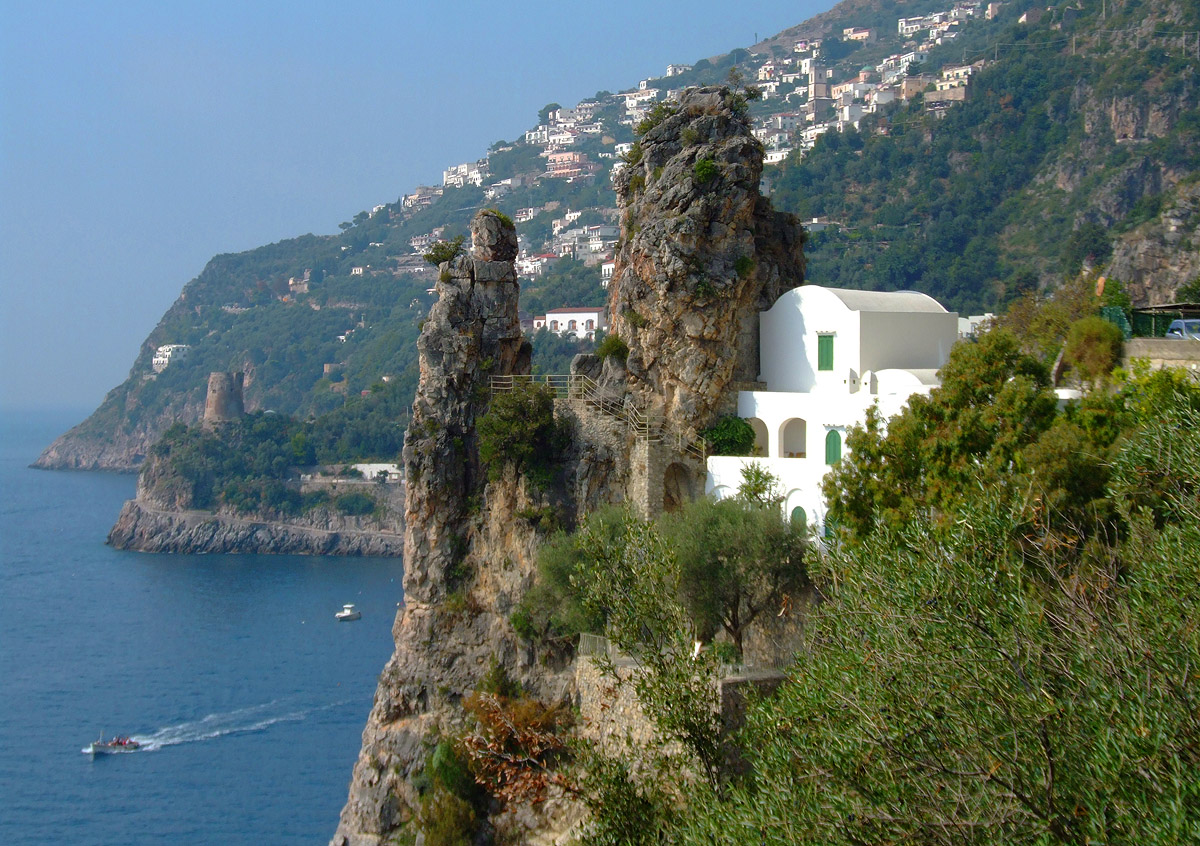 |
|||
| In 2009, I walked most of the way from Positano to Amalfi. It was an exciting journey taking care not to be run over by buses and cars on the narrow, twisting, cliff-clinging road. It was well worth taking the risk as the views were spectacular. | |||
 |
||
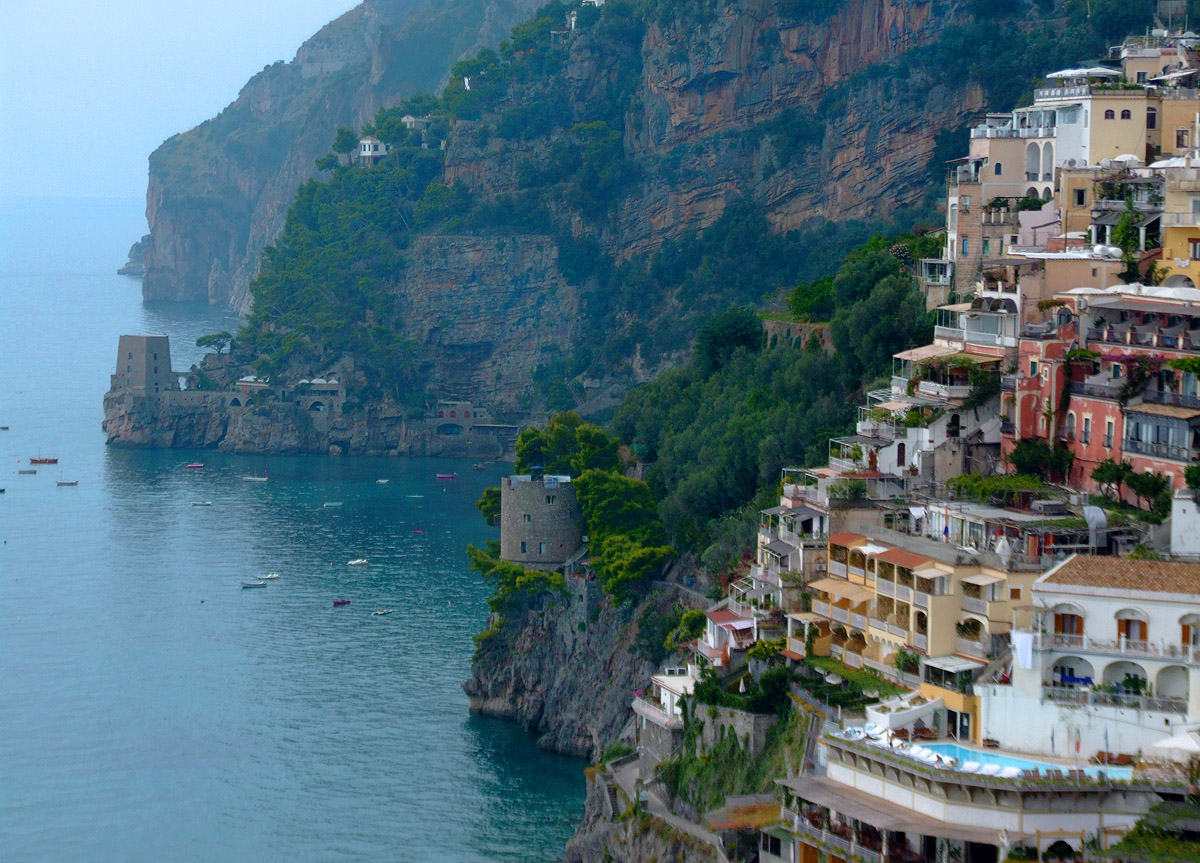 |
|||
| Positano, with its houses cascading down towards the Sea. | |||
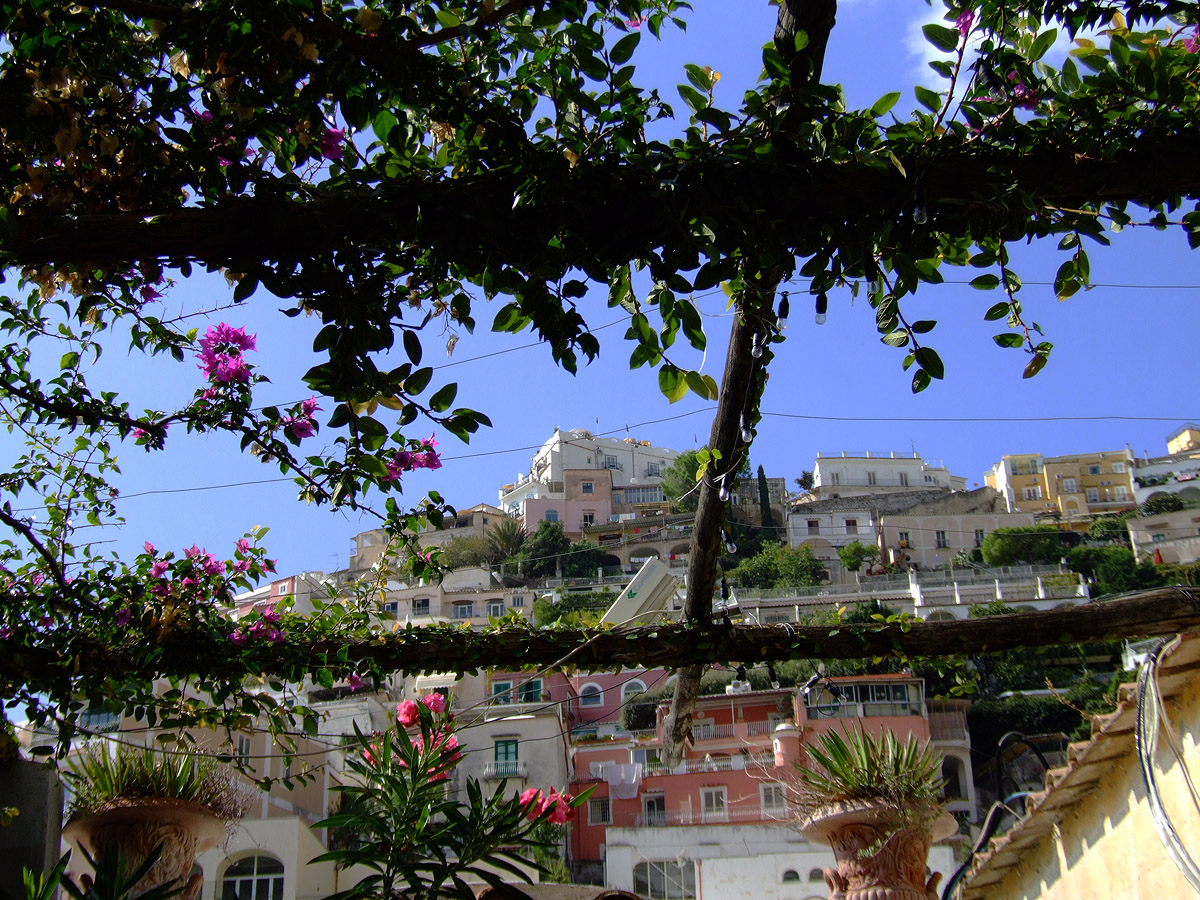 |
|||
| Positano. | |||
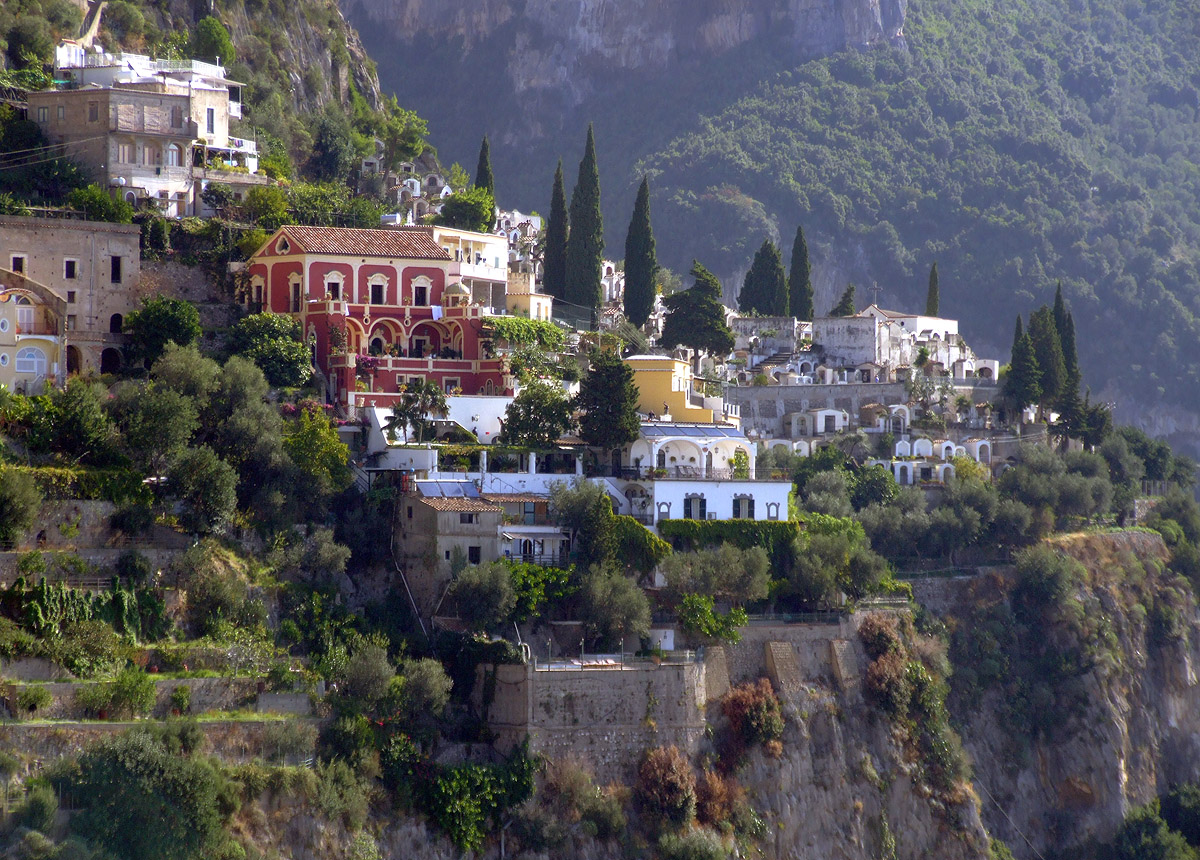 |
|||
| The upper section of Positano. You can see the cemetery with the Cypress trees beyond the houses, at the top of the photo. | |||
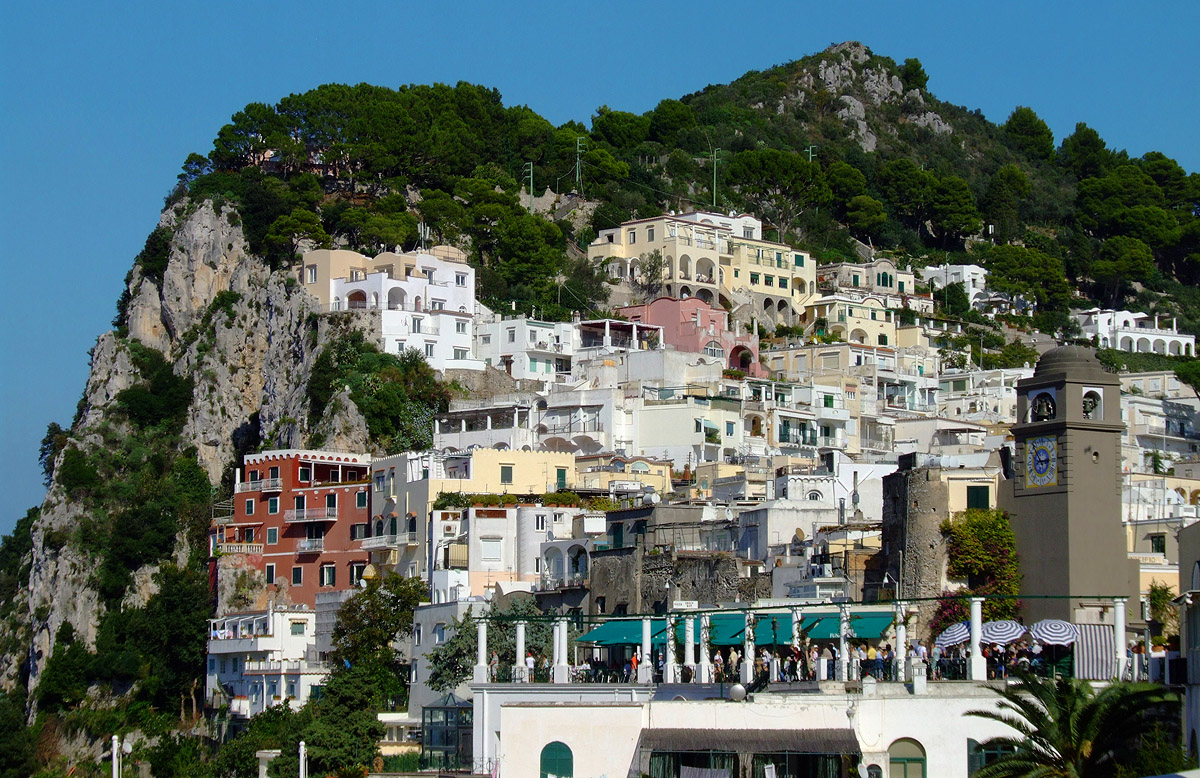 |
|||
| Capri. There was a lively party on the terrace at the bottom of the photo when I was there in 2009.
Capri has been a magnet for pleasure seekers since the time of the Roman Emperor Augustus. The Emperor Tiberius moved to Capri and ran his Empire from there until his death in 37 AD. Apparently, the Russian writer Maxim Gorky lived in the Villa Behring which is the reddish brown building under the cliff, on the left of the photo. |
|||
 |
|||
| This view of the rocky islands is in the South of the Island of Capri, not far from the Marina Piccola. The main island on the right of the photo is I Faraglioni. | |||
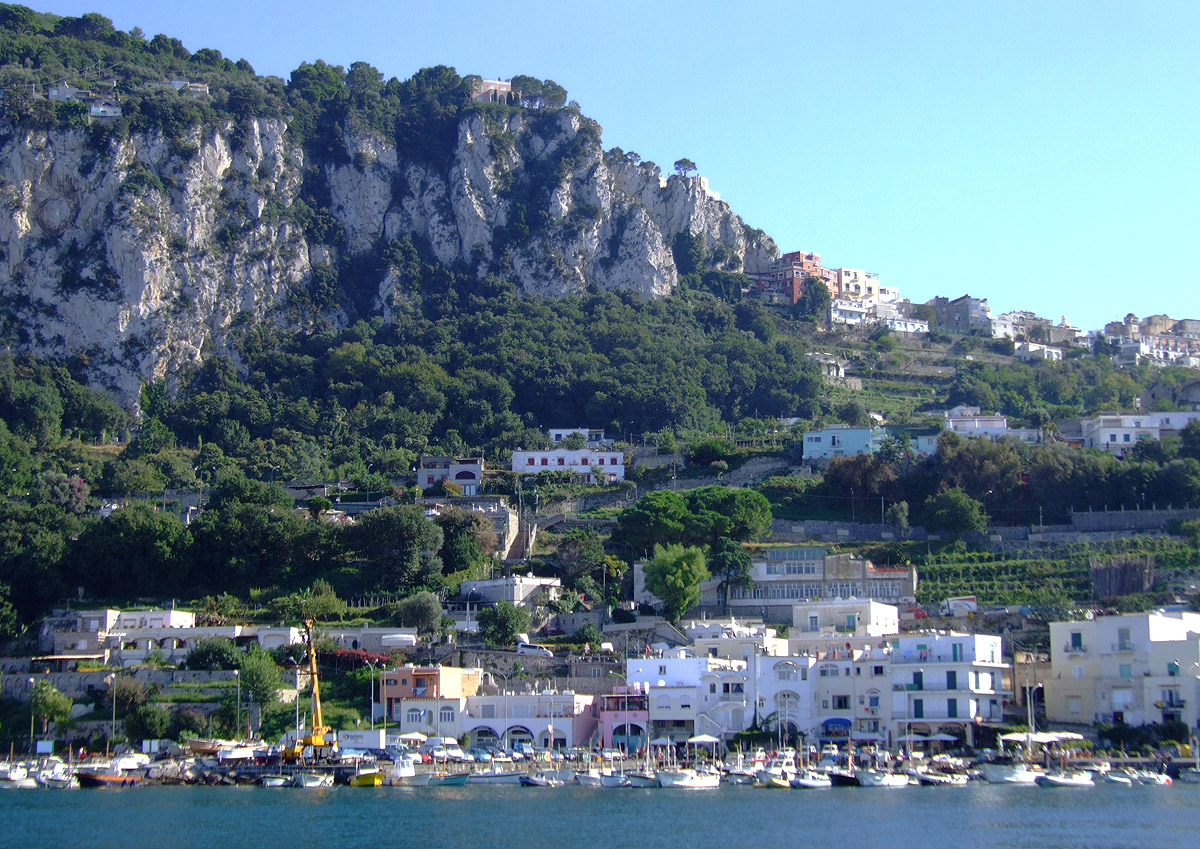 |
|||
| This is the view from the ferry of the Marina Grande, the main port of Capri on its Northern shore. | |||
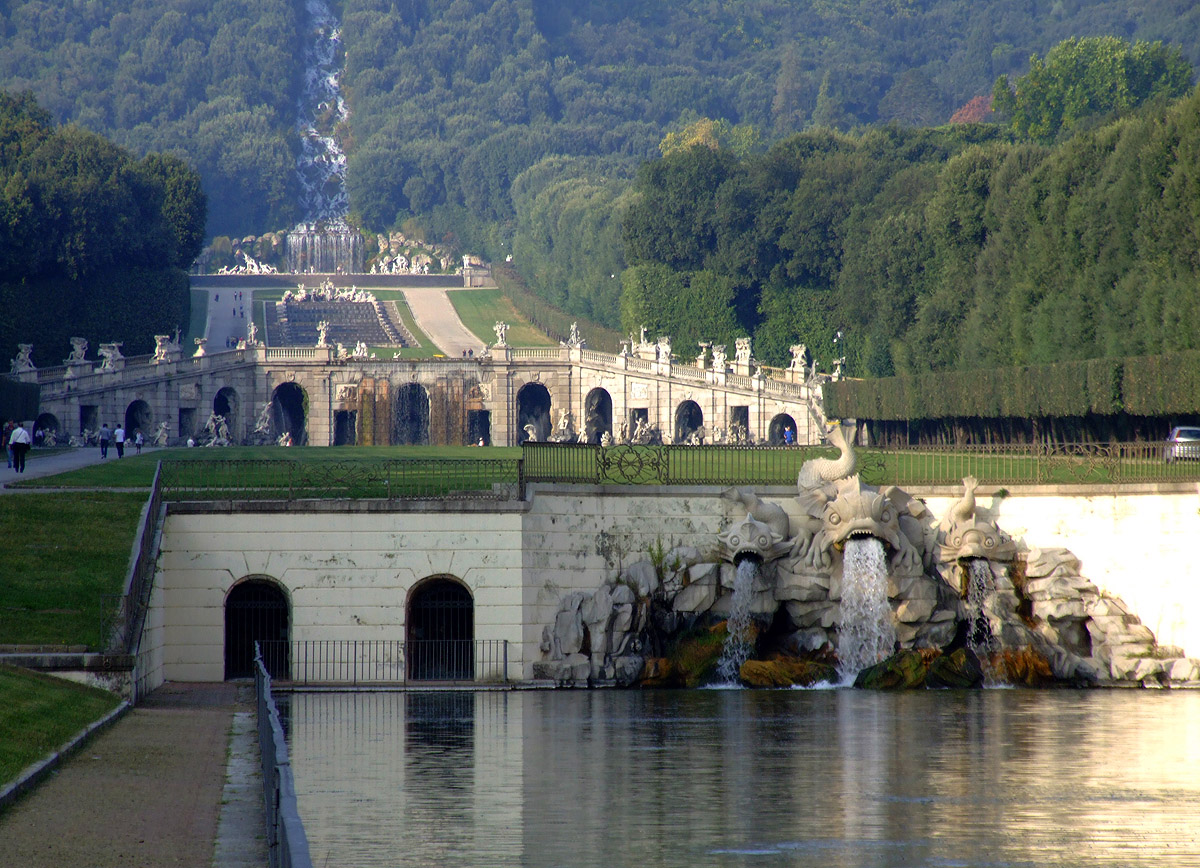 |
|||
| The Water Garden of the Palace of Caserta. Caserta is inland, North of Naples, and can be reached easily by train.
To ensure that the water supply for the cascades would be secure, the Bourbon Kings of Naples bought the whole mountain above it. |
|||
 |
|||
| The Royal Palace of Caserta was constructed for the Bourbon Kings of Naples during the 18th Century. It is a masterpiece of Baroque art and architecture. | |||
 |
||
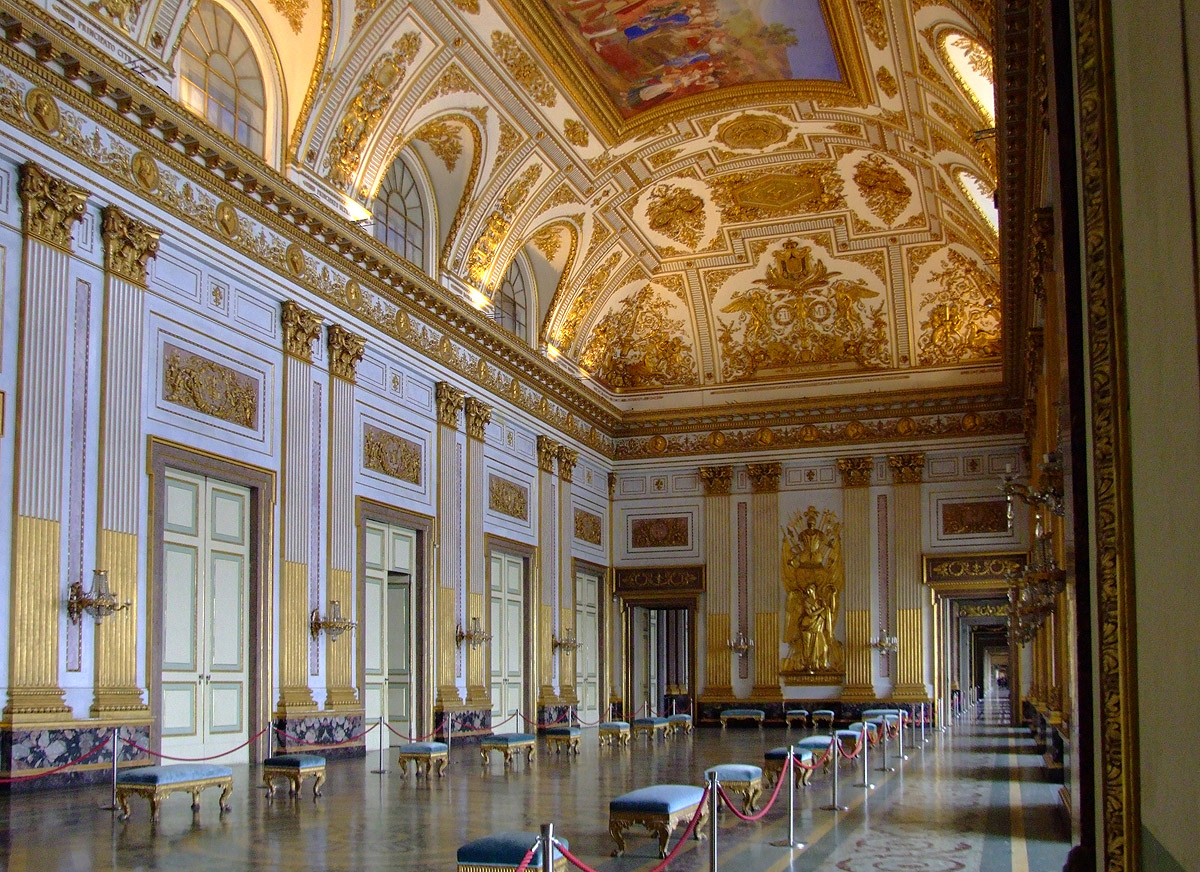 |
|||
| A room in the Royal Palace in Caserta. | |||
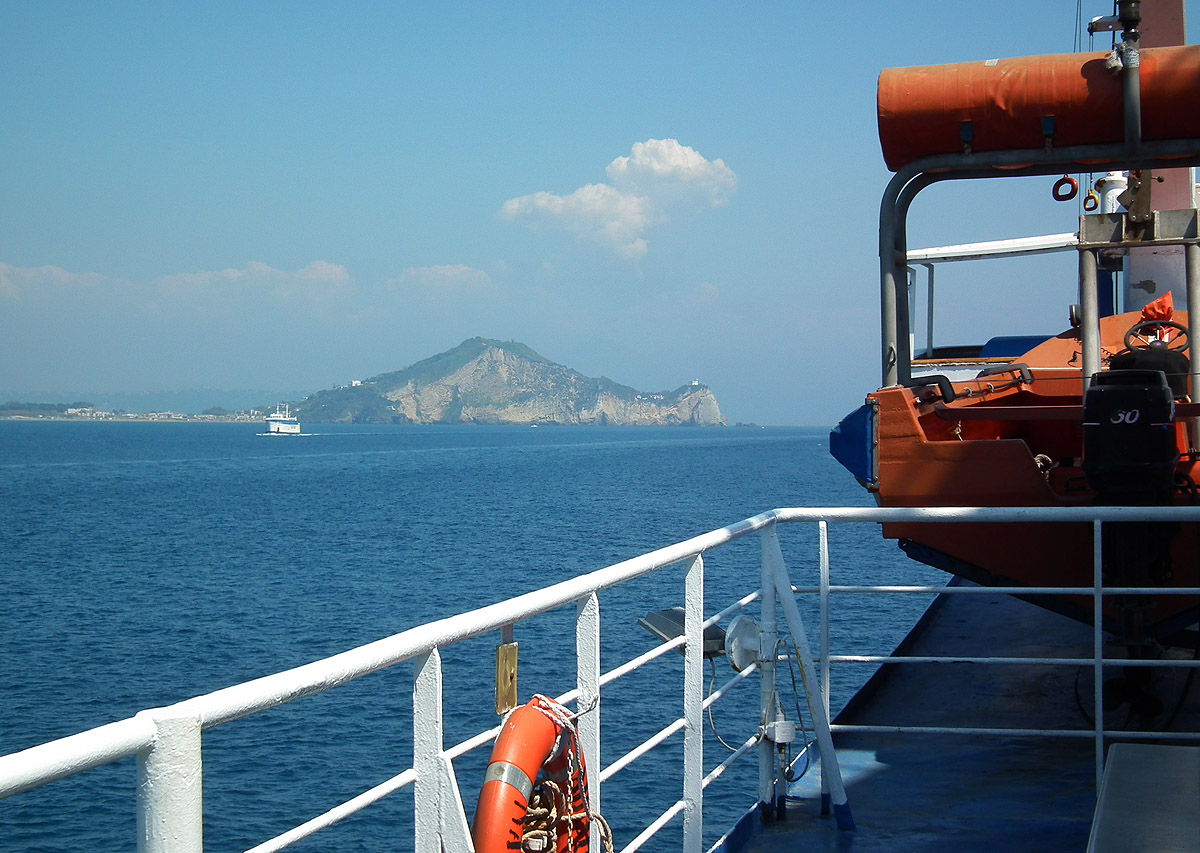 |
|||
| On a ferry from Naples to the island of Ischia. | |||
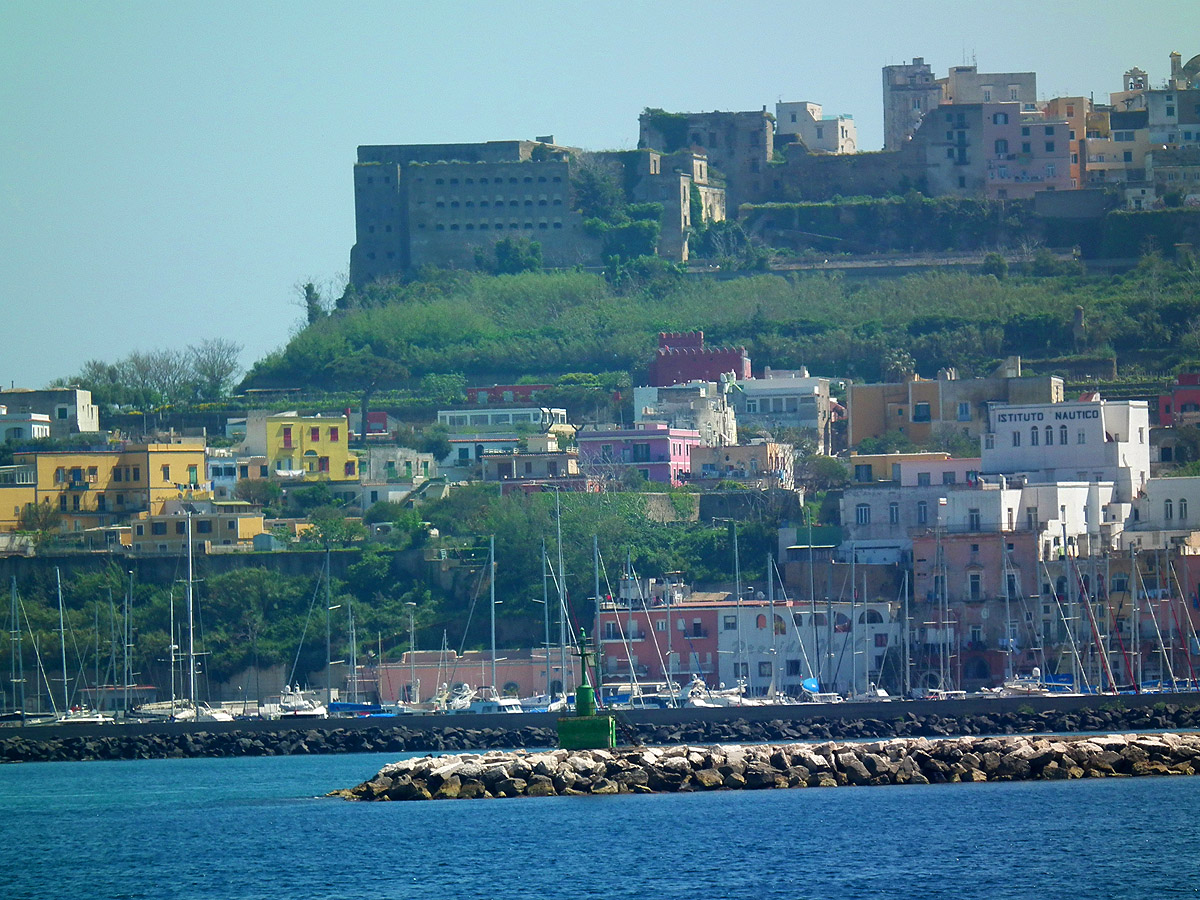 |
|||
| On the way to Ischia, we pass the island of Procida. | |||
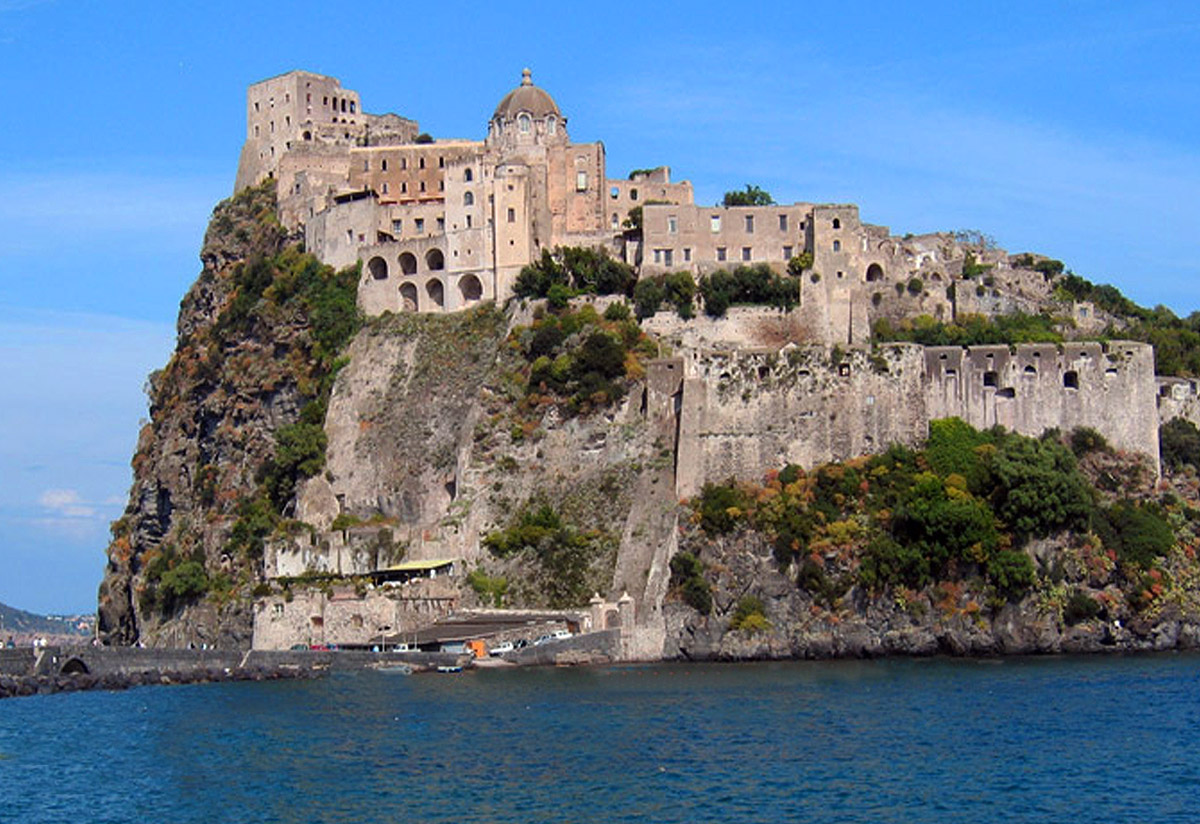 |
|||
| This is the Castello Aragonese off the coast of Ischia. It was on an island but it is now joined to Ischia by a causeway, which you can see on the left of the photo.
The original Castle was built in 474 BC by Hiero I of Syracuse, but it has since endured severe destruction and rebuilding. |
|||
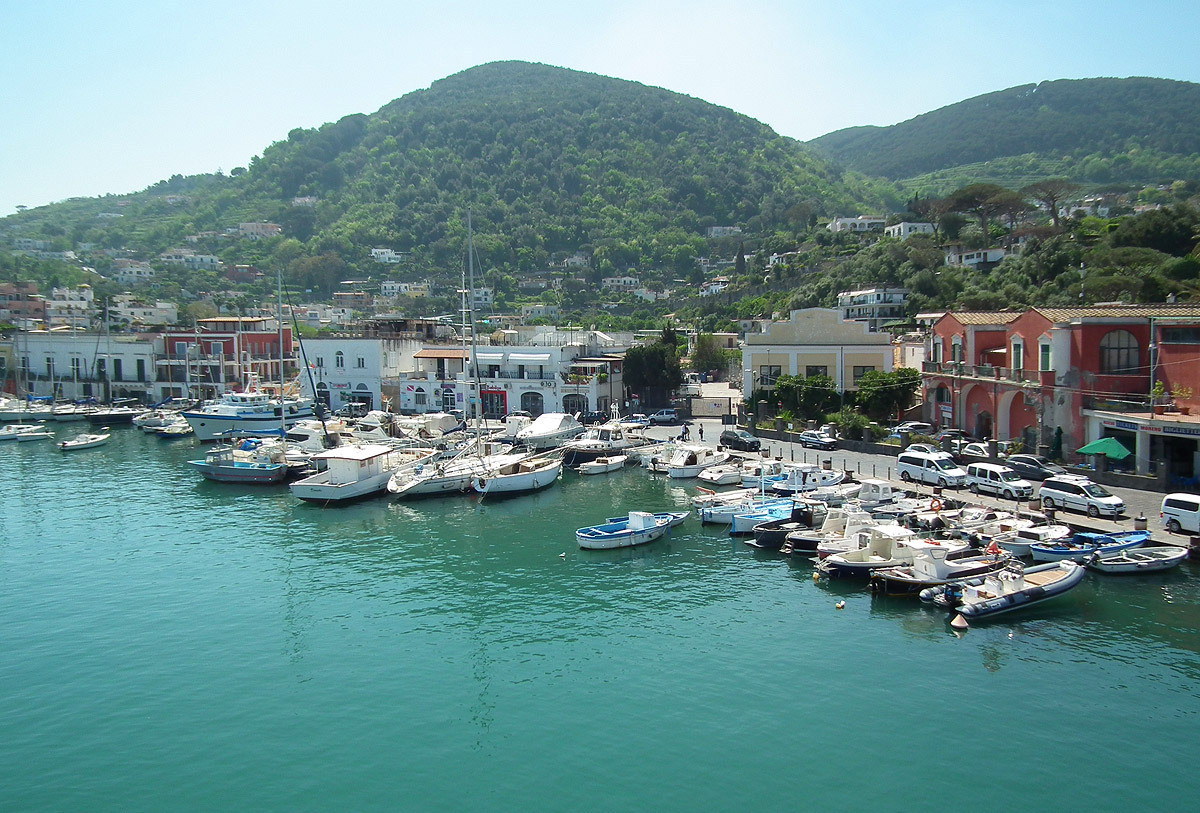 |
|||
| A view of the Port of Ischia, taken from the upper deck of the ferry. | |||
 |
|||
| This rock off the Northern shore of Ischia is called Il Fungo (the Mushroom). | |||
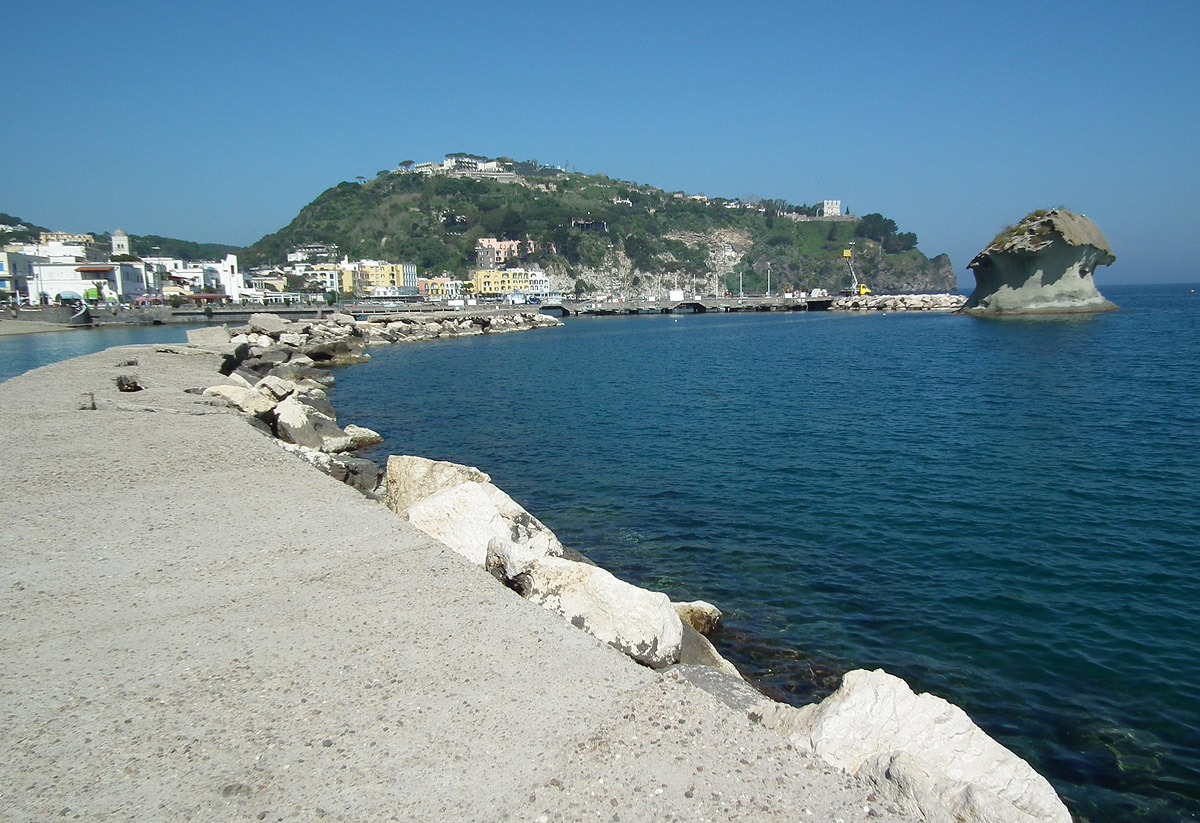 |
||
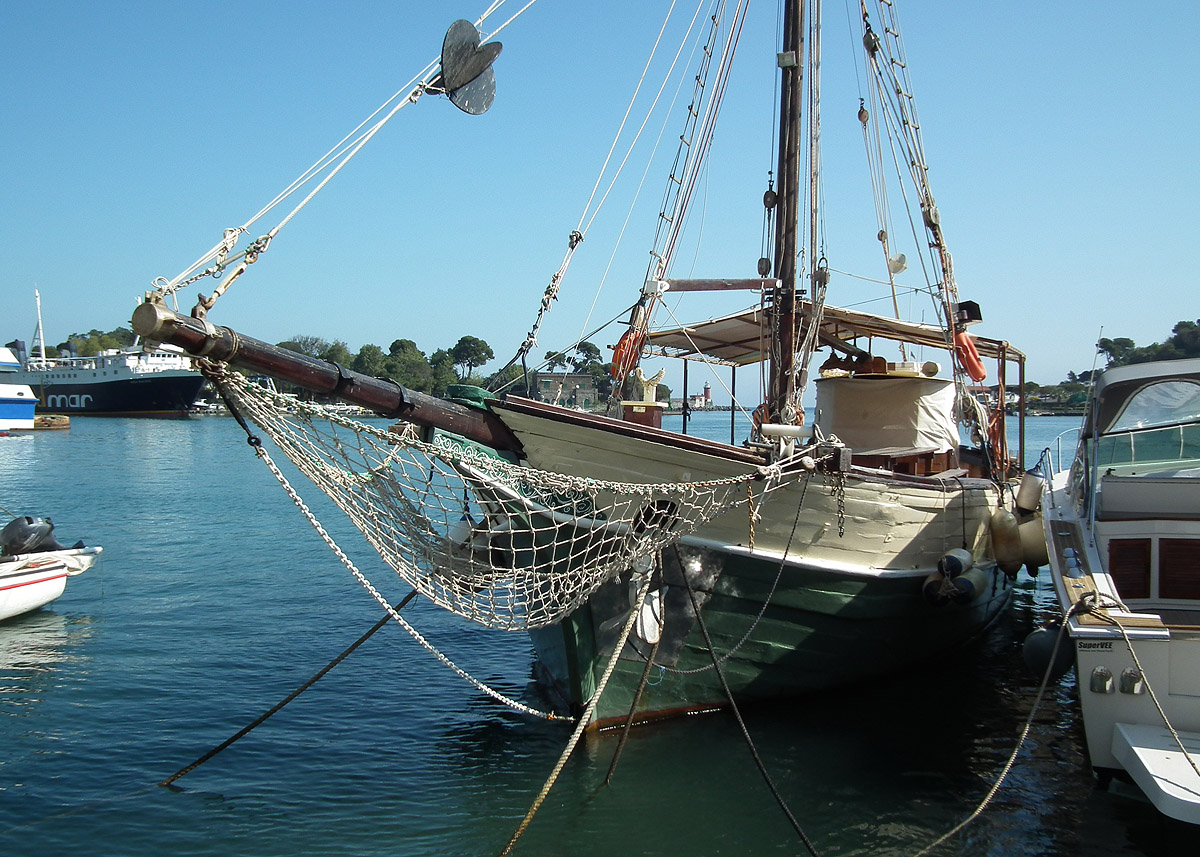 |
|||
| In the Port of Ischia. | |||
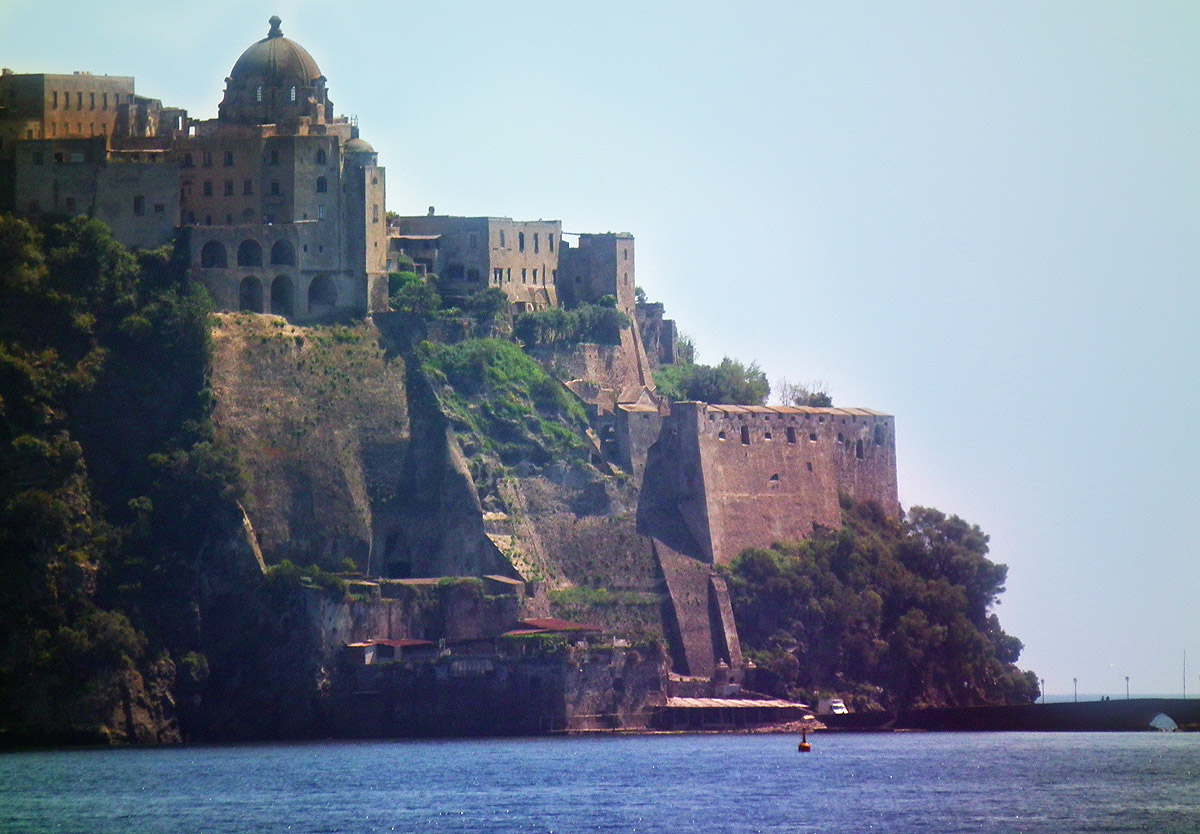 |
|||
| This view of the Southern end of the Aragonese Castle was taken with the full telescopic lens of my camera, from the ferry returning to Naples. | |||
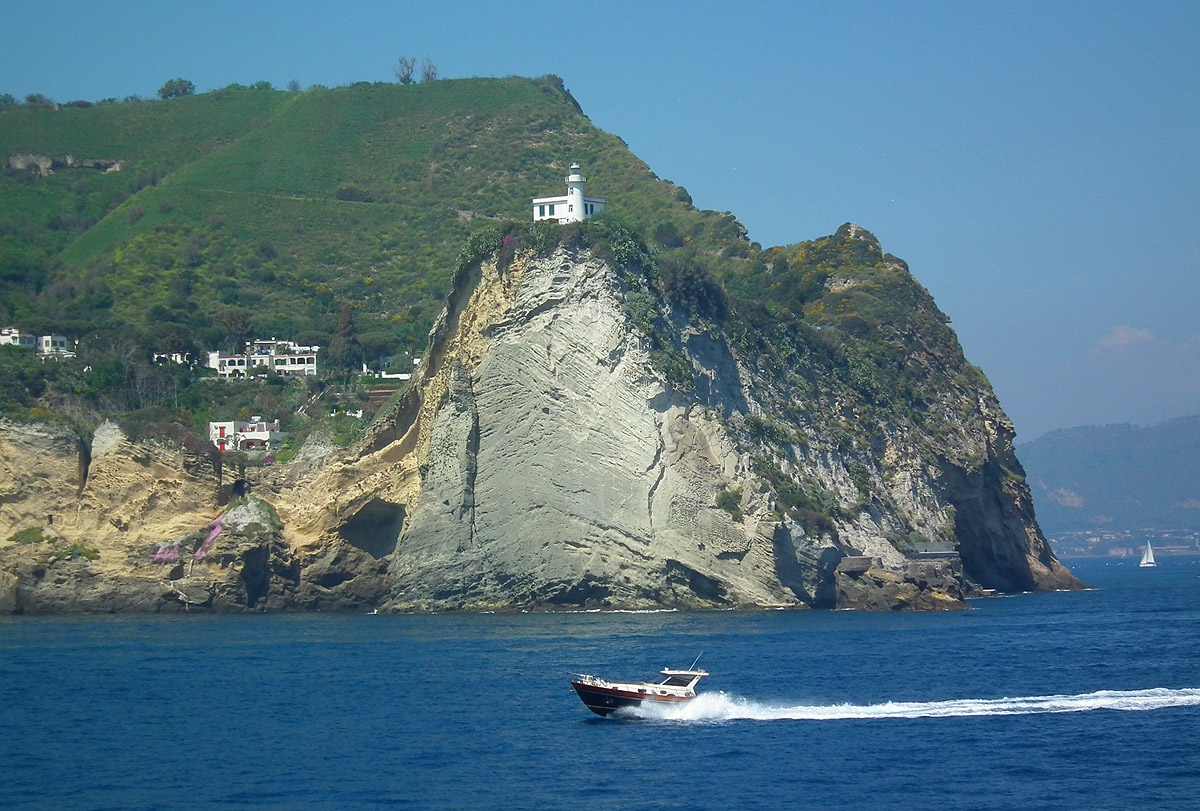 |
|||
| We end this visit to Naples and its close neighbours with this image of the lighthouse on the Italian mainland called the Faro Capo Miseno. | |||
|
To return to the Paintings section of this website, please CLICK HERE
|
|||